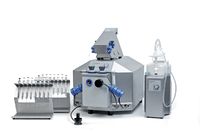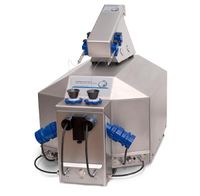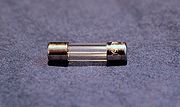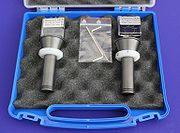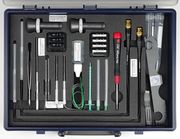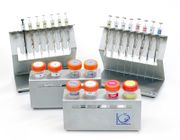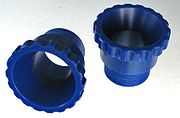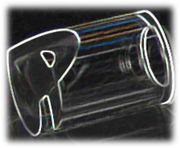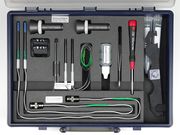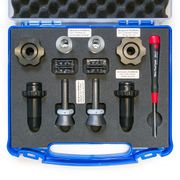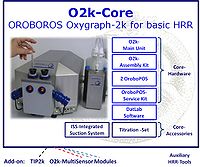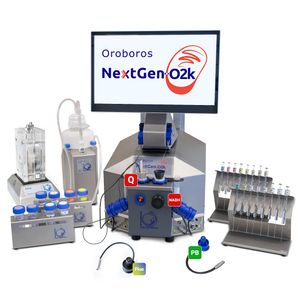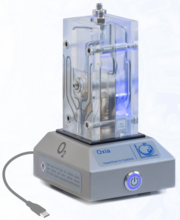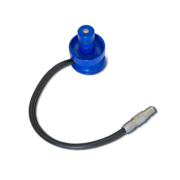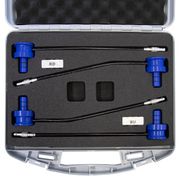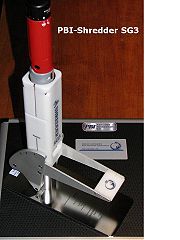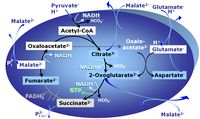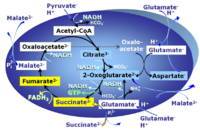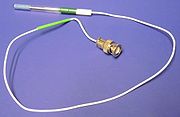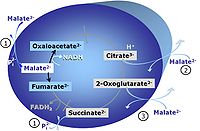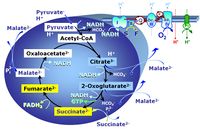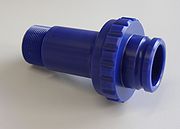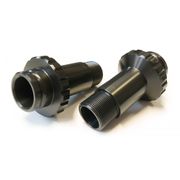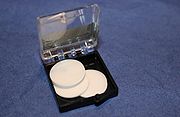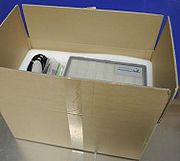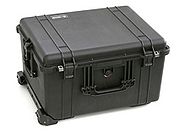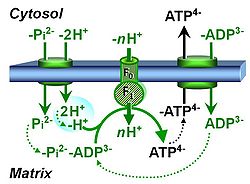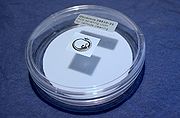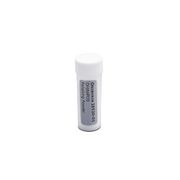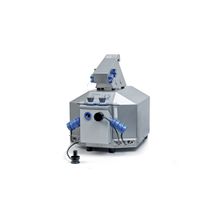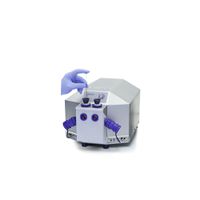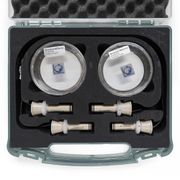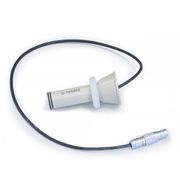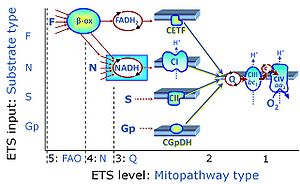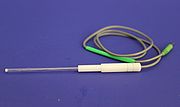Semantic search
| Term | Abbreviation | Description |
|---|---|---|
| O2k-FluoRespirometer | The Oroboros O2k-FluoRespirometer - the experimental system complete for high-resolution respirometry (HRR), including fluorometry, the TIP2k and the O2k-sV-Module allowing simultaneous monitoring of oxygen consumption together with either ROS production (AmR), mt-membrane potential (TMRM, Safranin and Rhodamine 123), Ca2+ (CaG) or ATP production (MgG). The O2k-FluoRespirometer supports all add-on O2k-Modules: O2k-TPP+ ISE-Module, O2k-pH ISE-Module, O2k-NO Amp-Module, enabling measurement of mt-membrane potential with ion sensitive electrodes (ISE for TPP+ or TPMP+) or pH. | |
| O2k-Fluorometer Series G | O2k-Fluorometer Series G - Former Series (up to 2017-July) - the experimental system complete for high-resolution respirometry (HRR) combined with fluorometry. The O2k-Fluorometer includes the O2k-Core, O2k-Fluo LED2-Module and TIP2k, and supports all other add-on O2k-Modules of the Oroboros O2k. The O2k is a sole source apparatus with no other instruments meeting its test experiments on O2k-Specifications. | |
| O2k-Fuse Power Plug\M2.5 A\5x20 mm | O2k-Fuse Power Plug\M2.5 A\5x20 mm: This item is a standard component of the O2k-Assembly Kit (O2k-FluoRespirometer), mounted on the socket for the O2k-Main Power Cable, at the rear panel of the O2k-Main Unit. | |
| O2k-Main Basic | The O2k-Main Basic is an integral element of the O2k-Main Unit. The Oroboros O2k Main Basic has the following components:
| |
| O2k-Main Power Cable | O2k-Main Power Cable, for connecting the main unit to the power supply. | |
| O2k-Main Power Cable\120 V\US-CA | O2k-Main Power Cable\120 V\US-CA, USA and Canada (120 V). | |
| O2k-Main Power Cable\230 V\AU-NZ | O2k-Main Power Cable\AU-NZ, Australia and New Zealand (230 V). | |
| O2k-Main Power Cable\230 V\Europe | O2k-Main Power Cable\230 V\Europe. | |
| O2k-Main Unit | The O2k-Main Unit is a component of the O2k-Core. The O2k-Main Unit consists of functionally defined, integral elements, the (O2k-Main Basic, O2k-Peltier Temperature Control, two O2k-Electromagnetic Stirrer Twin-Control units, two O2k-Amperometric OroboPOS Twin-Channels, O2k-Barometric Pressure Transducer), which cannot be obtained separately. | |
| O2k-MultiSensor | When one (or more) analytical parameters are monitored simultaneously with oxygen concentration and oxygen flux, this is an O2k-MultiSensor application of the Oroboros O2k-technology. The NextGen-O2k supports all O2k-MultiSensor Modules, while the O2k does not provide for the Q- and NADH-Redox-Modules. For some O2k-MultiSensor applications it is necessary to introduce one or more additional sensors into the chamber through a MultiSensor stopper. Optical applications require the standard black stoppers. | |
| O2k-NO Amp-Module | O2k-NO Amp-Module: NO-sensor compatability pack an amperometric add-on for O2k-MultiSensor application The NO sensor is not included. | |
| O2k-Network Reference Laboratory | O2k-Network Lab |
O2k-Network Reference Laboratories build a WorldWide network on high-resolution respirometry and mitochondrial physiology, the Oroboros O2k-Network. |
| O2k-Open Support agreement | O2k-Open Support aims at providing expert help quickly. Please, help us sharing our support communication openly with the scientific community. | |
| O2k-Peltier Temperature Control | O2k-Peltier Temperature Control: Built-in electronic thermostat controlling temperature for two O2k-chambers in the range of 4 to 47 °C; ±0.002 °C (at room temperature). Continuous recording of the O2k-Copper Block temperature with DatLab. Temperature change from 20 to 30 °C within 15 min; cooling from 30 to 20 °C within 20 min. Integral component of the O2k-Main Unit. The electronic temperature control of the O2k replaced the conventional water jacket. | |
| O2k-Publications: Exercise physiology;nutrition;life style | ||
| O2k-Publications: Obesity | ||
| O2k-Specifications | O2k versus multiwell respirometer: O2k stands for Oroboros O2k and high-resolution respirometry, meeting powerful quality criteria securing high output and pioneering state-of-the-art comprehensive OXPHOS analysis of substrate control and coupling control of mitochondrial function. 'High throughput' stands for disposable multiwell systems - expensive, with limited scope and extremely high running costs. In respirometry, high throughput is not equivalent to high output. If you’re using a biased instrument, it doesn’t matter how many measurements you take – you’re aiming at the wrong target (Silver 2012 Penguin Press). | |
| O2k-TPP+ ISE-Module | O2k-TPP+ ISE-Module: Potentiometric ion-selective electrodes for measurement of mitochondrial membrane potential | |
| O2k-Titration Set | The O2k-Titration Set consists of Hamilton microsyringes (6 x 10 mm3 and 3 spare plungers, 6 x 25 mm3, 1 x 50 mm3, 1 x 100 mm3, 1 x 500 mm3; fixed needles with rounded tips), provided in the Syringe Storage Box with Syringe Labels, a set of two Syringe Racks with Syringe Collars, and a set of two Tube Racks. | |
| O2k-USB Flash Drive | The O2k-USB Flash Drive is a component of the Oroboros O2k containing: DatLab, O2k-Manual, O2k-Protocols, O2k-Publications, and info on O2k-Workshops. | |
| O2k-Virtual Support | O2k-Virtual support includes 8 individual hours. Via a live video link, Oroboros experts guide you step-by-step on topics of your choice, such as O2k instrumental setup and service of the polarographic oxygen sensors (POS) for instrumental quality control, an essential component of HRR. This offers the opportunity to analyze and discuss your experimental DatLab files obtained with your O2k with the bioenergetics experts of Oroboros. It offers flexibility to participants and gives the option to choose virtual sessions that best fit individual needs. | |
| O2k-Window Frame |
O2k-Window Frame: blue POM, with thread for fixation on the O2k-Main Unit, to be removed only for rare cleaning purposes and for front fixation of the Fluorescence-Control Unit, using the O2k-Window Tool. | |
| O2k-Window Tool |
O2k-Window Tool for removing the blue O2k-Window Frame from the O2k-Main Unit, for rare cleaning purposes and for front fixation of the Fluorescence-Control Unit. | |
| O2k-chamber |
O2k-Chamber: Duran® glass polished, with standard operation volumes (V) of 2.0 mL or 0.5 mL (small chamber volume in the O2k-sV-Module, 12 mm inner diameter). The optical properties of Duran® allow application of fluorometric sensors (Duran® optical properties). | |
| O2k-pH ISE-Module | O2k-pH ISE-Module: two pH electrodes and reference electrodes and accessories | |
| O2k-sV-Module | O2k-sV-Module |
The O2k-sV-Module is the O2k small-volume module, comprised of two Duran® glass chambers of 12 mm inner diameter specifically developed to perform high-resolution respirometry with reduced amounts of biological sample, and all the components necessary for a smaller operation volume V of 0.5 mL. The current DatLab version is included in the delivery of this revolutionary module. |
| O2k-ticket system | The O2k-ticket system is a customer support platform based on Zammad. This system automatically attributes an unique Ticket number (which is visible on the subject of your e-mail) to each received customer inquiry. For an easy follow-up, all the related correspondence is collected under this Ticket number.
In order to provide a helpful and reliable support regarding your O2k/equipment, we suggest to include in your inquiries:
| |
| OSF Preprint server | Leading preprint service providers use OSF Preprints as an open source infrastructure to support their communities. You should upload your preprint to whichever preprint server best fits your topic and the community that you would like to reach. If there isn’t a community-driven preprint server for your discipline, OSF Preprints is available for any discipline. Currently, you can only share your preprint on one community preprint server. It’s on our roadmap to allow users to submit a preprint to multiple community preprint servers. However, to improve discoverability across communities, all preprints shared on OSF Preprints and community preprint servers are indexed and searchable via osf.io/preprints. Right now, it is not possible to add subjects. However, you can add tags with additional subject areas or keywords to improve discoverability. COS supports communities operating their own branded community preprint services using OSF Preprints as the backend.OSF is based in Charlottesville, VA, USA. | |
| OXPHOS International | The OXPHOS International web portal is a repository of information useful to scholars studying mitochondria. The site is operated as a private "special interests" community hub. | |
| OXPHOS capacity | P | |
| Obesity | Obesity is a disease resulting from excessive accumulation of body fat. In common obesity (non-syndromic obesity) excessive body fat is due to an obesogenic lifestyle with lack of physical exercise ('couch') and caloric surplus of food consumption ('potato'), causing several comorbidities which are characterized as preventable non-communicable diseases. Persistent body fat excess associated with deficits of physical activity induces a weight-lifting effect on increasing muscle mass with decreasing mitochondrial capacity. Body fat excess, therefore, correlates with body mass excess up to a critical stage of obesogenic lifestyle-induced sarcopenia, when loss of muscle mass results in further deterioration of physical performance particularly at older age. | |
| OctGM | OctGM | OctGM: Octanoylcarnitine & Glutamate & Malate. MitoPathway control state: FN |
| OctGMS | OctGMS | OctGMS: Octanoylcarnitine &Glutamate & Malate& Succinate. MitoPathway control state: FNS |
| OctM pathway control state | OctM | OctM: Octanoylcarnitine & Malate. MitoPathway control state: F SUIT protocols: SUIT-002, SUIT-015, SUIT-016, SUIT-017 Respiratory stimulation of the FAO-pathway, F, by fatty acid FA in the presence of malate M. Malate is a type N substrate (N), required for the F-pathway. In the presence of anaplerotic pathways (e.g., mitochondrial malic enzyme, mtME) the F-pathway capacity is overestimated, if there is an added contribution of NADH-linked respiration, F(N) (see SUIT-002). The FA concentration has to be optimized to saturate the FAO-pathway, without inhibiting or uncoupling respiration. Low concentration of malate, typically 0.1 mM, does not saturate the N-pathway; but saturates the F-pathway. High concentration of malate, typically 2 mM, saturates the N-pathway. |
| OctPGM pathway control state | OctPGM | OctPGM: Octanoylcarnitine & Pyruvate & Glutamate & Malate. MitoPathway control state: FN SUIT protocols: SUIT-002
|
| OctPGMS pathway control state | OctPGMS | OctPGMS: Octanoylcarnitine & Pyruvate & Glutamate & Malate & Succinate. MitoPathway control state: FNS SUIT protocol: SUIT-001, SUIT-002, SUIT-015 This substrate combination supports convergent electron flow to the Q-junction. |
| OctPGMSGp pathway control state | OctPGMSGp | OctPGMSGp: Octanoylcarnitine & Pyruvate & Glutamate & Malate & Succinate & Glycerophosphate. MitoPathway control state: FNSGp SUIT protocol: SUIT-002 This substrate combination supports convergent electron flow to the Q-junction. |
| OctPM pathway control state | OctPM | OctPM: Octanoylcarnitine & Pyruvate & Malate. MitoPathway control state: FN SUIT protocol: SUIT-002, SUIT-005 This substrate combination supports N-linked flux which is typically higher than FAO capacity (F/FN<0 in the OXPHOS state). In SUIT-RP1, PMOct is induced after PM(E), to evaluate any additive effect of adding Oct. In SUIT-RP2, FAO OXPHOS capacity is measured first, testing for the effect of increasing malate concentration (compare malate-anaplerotic pathway control state, M alone), and pyruvate is added to compare FAO as the background state with FN as the reference state. |
| OctPMS | OctPMS | OctPMS: Octanoylcarnitine & Pyruvate & Malate & Succinate. MitoPathway control state: FNS SUIT protocol: SUIT-005 |
| Octanoate | Oca | Octanoate (octanoic acid). C8H16O2 Common name: Caprylic acid. |
| Octanoylcarnitine | Oct | Octanoylcarnitine is a medium-chain fatty acid (octanoic acid: eight-carbon saturated fatty acid) covalently linked to carnitine, frequently applied as a substrate for fatty acid oxidation (FAO) in mitochondrial preparations. |
| Oligomycin | Omy | Oligomycin (Omy) is an inhibitor of ATP synthase by blocking its proton channel (Fo subunit), which is necessary for oxidative phosphorylation of ADP to ATP (energy production). The inhibition of ATP synthesis also inhibits respiration. In OXPHOS analysis, Omy is used to induce a LEAK respiration state of respiration (abbreviated as L(Omy) to differentiate from L(n), LEAK state in the absence of ADP). |
| Open - DatLab | Ctrl+O | Open a previously recorded DatLab file. |
| Open Access | OA | Open Access (OA) academic articles comprise all different forms of published research that are distributed online, free of charge and with an open license to facilitate the distribution and reuse. The open access repositories serve as the perfect vehicle to transmit free knowledge, including but not limited to peer-reviewed and non-peer-reviewed academic journal articles, conference papers, theses, book chapters and monographs. Driven by the problems of social inequality caused by restricting access to academic research, the Open Access movement changes the funding system of published literature allowing for more readers and thus increased access to scientific knowledge, as well as addressing the economic challenges and unsustainability of academic publishing. In addition to being free to read (gratis), open access articles may also be free to use (libre) where the copyright is held by the authors and not the publisher. Definition by the Directory of Open Access Journals (DOAJ): "We define these as journals where the copyright holder of a scholarly work grants usage rights to others using an open license (Creative Commons or equivalent) allowing for immediate free access to the work and permitting any user to read, download, copy, distribute, print, search, or link to the full texts of articles, crawl them for indexing, pass them as data to software, or use them for any other lawful purpose." |
| Open Science | OS | Building on the essential principles of academic freedom, research integrity and scientific excellence, open science sets a new paradigm that integrates into the scientific enterprise practices for reproducibility, transparency, sharing and collaboration resulting from the increased opening of scientific contents, tools and processes. Open science is defined as an inclusive construct that combines various movements and practices aiming to make multilingual scientific knowledge openly available, accessible and reusable for everyone, to increase scientific collaborations and sharing of information for the benefits of science and society, and to open the processes of scientific knowledge creation, evaluation and communication to societal actors beyond the traditional scientific community. It comprises all scientific disciplines and aspects of scholarly practices, including basic and applied sciences, natural and social sciences and the humanities, and it builds on the following key pillars: open scientific knowledge, open science infrastructures, science communication, open engagement of societal actors and open dialogue with other knowledge systems. |
| Open chamber | O | The term "open O2k-chamber" refers to a situation in which the liquid phase is allowed to equilibrate with a gas phase, but the stopper is partially inserted using the Stopper-Spacer. |
| Open system | An open system is a system with boundaries that allow external exchange of energy and matter; the surroundings are merely considered as a source or sink for quantities transferred across the system boundaries (external flows, Iext). | |
| Optics | Optics are the components that are used to relay and focus light through a spectrofluorometer or spectrophotometer. These would normally consist of lenses and/or concave mirrors. The number of such components should be kept to a minimum due to the losses of light (5-10%) that occur at each surface. | |
| Ordinate | y | The ordinate is the vertical axis y of a rectangular two-dimensional graph with the abscissa x as the horizontal axis. Values Y are placed vertically from the origin. |
| OroboPOS |
The OroboPOS is a polarographic oxygen sensor (POS), with an amperometric mode of operation. The OroboPOS meets the highest quality criteria in terms of linearity, stability and sensitivity of the signal. The Clark type polarographic oxygen sensor (POS) remains the gold standard for measuring dissolved oxygen in biomedical, environmental and industrial applications over a wide dynamic oxygen range. It consists of a gold cathode, a silver/silverchloride anode and a KCl electrolyte reservoir separated from the sample by a 25 µm membrane (FEP). The main body of the OroboPOS is made of PEEK. With application of a polarization voltage (0.8 V), a current is obtained as an amperometric signal, which is converted to a voltage. | |
| OroboPOS-Connector | OroboPOS-Connector (blue POM), with male connection to OroboPOS head (POS) and with cable and male plug fitting into O2k-Main Unit. | |
| OroboPOS-Connector Service | The OroboPOS-Connector Service entails routine maintenance and any necessary repairs of the OroboPOS-Connector in the Oroboros electronics workshop (WGT). | |
| Oroboros Instruments Corp |
| |
| Oroboros O2k-Core (O2k-Series D - G) | Oroboros O2k-Core - Former Series (O2k-Series D - G) - the experimental system complete for basic high-resolution respirometry (HRR). The O2k-Core includes the O2k-Main Unit with stainless steel housing, O2k-Assembly Kit, two OroboPOS (polarographic oxygen sensors) and OroboPOS-Service Kit, DatLab software, the ISS-Integrated Suction System and the O2k-Titration Set. The O2k-Core supports all add-on O2k-Modules of the O2k. On-line display of oxygen flux (rate of respiration) is provided in addition to the conventional 'oxygraphic' plot of oxygen concentration over time. Highest signal stability minimizes the required amounts of biological sample, and provides the basis for resolution in the extreme low-oxygen range. Peltier temperature control provides a thermal stability at ±0.002 °C in the range of 4 °C to 47 °C at typical constant room temperature. Electronically controlled PVDF or PEEK stirrers are integrated in the two-chamber design of the O2k, and a barometric pressure transducer enables automatic oxygen calibrations implemented in the DatLab software. The O2k is a sole source apparatus with no other instruments meeting its specifications. | |
| Oroboros O2k-technology |
The Oroboros O2k-technology provides modular systems for high-resolution respirometry (HRR) for mitochondria and cell research. Oroboros delivers the O2k-technology for high-resolution respirometry in mitochondria and cell research. The O2k-tecnology allows the measurement of respiration at controlled oxygen levels, combined with redox biology (NADH and CoQ), ROS production, mitochondrial membrane potential, ATP production, Ca2+, or pH. HRR expands to HRPB: High-Resolution PhotoBiology. Small amounts of biological samples can be used for bioenergetic and OXPHOS analysis, ranging from isolated mitochondria, permeabilized tissues and permeabilized cells to living cells and tissues slices. The modular O2k-concept is supported by DatLab, with high flexibility for extension by add-on O2k-Modules. All O2k-Modules are supported by the NextGen-O2k. The O2k-Q-Module and the O2k-NADH-Module are exclusively supported by the NextGen-O2k, whereas the O2k (Series-J) provides the basis for all other HRR application but cannot be upgraded to the NextGen-O2k Redox. The globally tested and trusted high-resolution O2k-technology prioritizes both quality and scientific research output in the field of mitochondrial physiology and pathology, extended to PhotoBiology. | |
| Oroboros USB-flash drive | The Oroboros USB-flash drive is delivered with the Oroboros O2k. Copy the folder "Oroboros O2k-Course on HRR" from the Oroboros USB-flash drive to your computer. This folder contains the DatLab installation program as well as tools to find topics, O2k-manuals and O2k-protocols with corresponding DatLab demo files and templates for training with DatLab. | |
| Ouabain | Oua | Ouabain (synonym: G-strophantin octahydrate) is a poisonous cardiac glycoside. The classical mechanism of action of ouabain involves its binding to and inhibition of the plasma membrane Na+/K+-ATPase (sodium pump) especially at the higher concentrations. Low (nanomolar and subnanomolar) concentrations of ouabain stimulate the Na-K-ATPase. |
| Outlier | An outlier is a member of a set of values which is inconsistent with other members of that set. An outlier can arise by chance from the expected population, originate from a different population, or be the result of an incorrect recording or other blunder. Many schemes use the term outlier to designate a result that generates an action signal. This is not the intended use of the term. While outliers will usually generate action signals, it is possible to have action signals from results that are not outliers [SOURCE: ISO 5725‑1:1994, modified]. | |
| Outlier index threshold - DatLab | ||
| Outlier-skewness index | OSI, OI | An outlier-skewness index OSI is defined for evaluation of the distribution of data sets with outliers including separate clusters or skewness in relation to a normal distribution with equivalence of the average and median. The OSI is derived from Pearson’s coefficient of skewness 2:
The outlier-skewness index OSI introduces the absolute value of the arithmetic mean, m = ABS(average + median)/2, for normalization:
At the limit of a zero value of m, the OSI equals the Pearson 2 coefficient (without the multiplication factor of 3). At high m with small standard deviation (SD), the OSI is effectively the difference between the average and the median normalized for m, (average-median)/m. |
| Overfitting | Overfitting in statistics is the act of mistaking noise for a signal. Overfitting makes a model look ‘’better’’ on paper but perform ‘’worse’’ in the real world. This may make it easier to get the model published in an academic journal or to sell to a client, crowding out more honest models from the marketplace. But if the model is fitting noise, it has the potential to hurt the science (quoted from Silver 2012 Penguin Press). | |
| Overlay of plots - DatLab | Overlay of plots is defined in DatLab as selection of graph layouts showing identical plots from the two O2k-chambers in each graph. Overlay of plots is selected in Graph layout. Superimposed traces of flux/flow from chambers A and B are then shown in Graph 1, and of concentration in chambers A and B in Graph 2. There are basically two ways to superimpose traces recorded in different experiments: Export of the graphics via windows metafile or export of the data to e.g. a spreadsheet program. If you export via wmf you also can manipulate the graphics but then usually the lines are broken up in different segments. This can be done in various programs like MS Word, Open Office Draw and even in MSPower Point, though this maybe is the worst program to do this. It is better to manipulate them in a proper program like OO Draw, convert it to an unchangeable picture and then import it to a presentation graphics. Anyway, when you import directly to Power point (or other programs), make sure not to import it as a "picture" but as a metafile. Also in some programs you might afterwards have to "break" it up, or accept a "conversion to a MS Draw object" or other similar linguistic inventions of the software gurus. For this option we suggest to do as much as possible directly in DatLab (setting colors, line widths, ..) using the options in "Plots"/"select plots" and "graph"/"options". The “hardcore“ option is to export the data and import it into e.g. a spreadsheet program (MS Excel , OOCalc). It takes longer to have a simple overlay but gives you far less problems later and its easier to make changes later. To do this you can export your dataset "Export"/"Data to Textfile" and then go from there. | |
| Oxaloacetate | Oa |
Oxaloacetic acid, C4H4O5, occurs under physiological conditions as the anion oxaloacetate2-, Oa. Oxaloacetate is formed from malate by MDH. Oa reacts with acetyl-CoA through citrate synthase to form citrate, or with glutamate through transaminase to form oxoglutarate and aspartate. Oa transport is restricted across the inner mt-membrane of various tissues. Oa is a potent inhibitor of succinate dehydrogenase. |
| Oxalomalic acid | Oxalomalic acid is an inhibitor of aconitase (and of cytoplasmic NADP-dependent isocitrate dehydrogenase). Aconitase mediates the isomerization of citrate to isocitrate as the first step in the TCA cycle. Oxalomalic acid has been used at 1 mM concentration and after 45 min of pre-incubation to inhibit aconitase in permeabilized rat Soleus muscle fibres, inhibiting the enzyme by 24% (Osiki 2016 FASEB J). | |
| Oxia | Oxia - HyperOxia to HypOxia: The Oxia generates gaseous oxygen and hydrogen by electrolysis of water using a proton exchange membrane (PEM). O2 and H2 gas can be used to control the O2 regime in the Oroboros O2k (Setting_the_oxygen_concentration) using the 10 mL Gas-Injection Syringes. Low oxygen concentrations (<50 µM) are used to mimic tissue normoxia or hypoxia. Hyperoxic conditions above air saturation (250-600 µM O2) are routinely used for high-resolution respirometry of permeabilized muscle fibers or to induce oxidative stress in cells and mitochondrial preparations. | |
| Oxidative phosphorylation | OXPHOS | |
| Oxidative stress | Oxidative stress results from an imbalance between pro-oxidants and antioxidants shifting the equilibrium in favor of the pro-oxidants. This process can be due by an increment in pro-oxidants, by a depletion of antioxidant systems or both. Oxidative stress generates oxidative damage of proteins, lipids and DNA. | |
| Oxoglutarate | Og |
2-Oxoglutaric acid or alpha-ketoglutaric acid, C5H6O5, occurs under physiological conditions as the anion 2-Oxoglutarate2-, Og. 2-Oxoglutarate (alpha-ketoglutarate) is formed from isocitrate as a product of isocitrate dehydrogenase (IDH) in the TCA cycle, and is a substrate of oxoglutarate dehydrogenase (OgDH). The 2-oxoglutarate carrier exchanges malate2- for 2-oxoglutarate2- as part of the malate-aspartate shuttle. In the cytosol, oxoglutarate+aspartate are transaminated to form oxaloacetate+glutamate. Cytosolic malate dehydrogenase converts oxaloacetate+NADH to malate. |
| Oxoglutarate dehydrogenase | OgDH | Oxoglutarate dehydrogenase (α-ketoglutarate dehydrogenase) is a highly regulated enzyme of the tricarboxylic acid cycle. It catalyses the conversion of oxoglutarate (alpha-ketoglutarate) to succinyl-CoA, reduces NAD+ to NADH and thus links to Complex I in the Electron transfer-pathway. OgDH is activated by low Ca2+ (<20 µM) but inactivated by high Ca2+ (>100 µM). OgDH is an important source of ROS. |
| Oxycaloric equivalent | DeltakHO2 | The oxycaloric equivalent is the theoretically derived enthalpy change of the oxidative catabolic reactions per amount of oxygen respired, DeltakHO2, ranging from -430 to -480 kJ/mol O2. The oxycaloric equivalent is used in indirect calorimetry to calculate the theoretically expected metabolic heat flux from the respirometrically measured metabolic oxygen flux. Calorimetric/respirometric ratios (CR ratios; heat/oxygen flux ratios) are experimentally determined by calorespirometry. A CR ratio more exothermic than the oxycaloric equivalent of -480 kJ/mol indicates the simultaneous involvement of aerobic and anaerobic mechanisms of energy metabolism. |
| Oxygen | O2 |
Molecular oxygen, O2 or dioxygen, has two atoms of oxygen, O, which is the chemical element with atomic number 8. The relative molecular mass of O2, Mr,O2, is 32 (or 31.9988). The element O has 8 protons, 8 neutrons and 8 electrons. In the figure, the two electrons in the first electron shell are not shown. Of the six electrons in the outer shell (blue bullets), one electron from each of the two atoms is shared in O2 forming the covalent bond, and one electron in each atom is unpaired. |
| Oxygen calibration - DatLab | O2 calibration is the calibration in DatLab of the oxygen sensor. It is a prerequisite for obtaining accurate measurements of respiration. Accurate calibration of the oxygen sensor depends on (1) equilibration of the incubation medium with air oxygen partial pressure at the temperature defined by the experimenter; (2) zero oxygen calibration; (3) high stability of the POS signal tested for sufficiently long periods of time; (4) linearity of signal output with oxygen pressure in the range between oxygen saturation and zero oxygen pressure; and (5) accurate oxygen solubility for aqueous solutions for the conversion of partial oxygen pressure into oxygen concentration. The standard oxygen calibration procedure is described below for high-resolution respirometry with the calibration routine using instrumental calibration DL-Protocols in DatLab. | |
| Oxygen flow | IO2 [mol·s-1] or [mol·s-1·x-1] | Respiratory oxygen flow is the oxygen consumption per total system, which is an extensive quantity. Flow is advancement of a transformation in a system per time [mol·s-1], when 'system' is defined as the experimental system (e.g. an open or closed chamber). Flow is distinguished from the size-specific quantity flux obtained by normalization of flow per volume of the experimental system [mol·s-1·m-3]. An experimental object, e.g. a living cell, may be considered as the 'experimental system'. Then oxygen flow per cell has the unit [mol·s-1·x-1], where [x] is the elementary unit for a count. Oxygen flow or respiration per cell [amol·s-1·x-1] = [pmol·s-1·Mx-1] is normalized for the cell count, distinguished from oxygen flux (e.g. per mg protein or wet mass). These are different forms of normalization of rate. |
| Oxygen flux | JO2 | Oxygen flux, JO2, is a specific quantity. Oxygen flux is oxygen flow, IO2 [mol·s-1 per system] (an extensive quantity), divided by system size. Flux may be volume-specific (flow per volume [pmol·s-1·mL-1]), mass-specific (flow per mass [pmol·s-1·mg-1]), or marker-specific (flow per mtEU). Oxygen flux (e.g., per body mass, or per cell volume) is distinguished from oxygen flow (per number of objects, such as cells), IO2 [mol·s-1·x-1]. These are different forms of normalization of rate. |
| Oxygen flux - instrumental background | J°O2 | Instrumental background oxygen flux, J°O2, in a respirometer is due to oxygen consumption by the POS, and oxygen diffusion into or out of the aqueous medium in the O2k-chamber. It is a property of the instrumental system, measured in the range of experimental oxygen levels by a standardized instrumental O2 background test. The oxygen regime from air saturation towards zero oxygen is applied generally in experiments with isolated mitochondria, and living or permeabilized cells. To overcome oxygen diffusion limitation in permeabilized fibers and homogenates, an elevated oxygen regime is applied, requiring instrumental background test in the same range of elevated oxygen. |
| Oxygen kinetics | Oxygen kinetics describes the dependence of respiration of isolated mitochondria or cells on oxygen partial pressure. Frequently, a strictly hyperbolic kinetics is observed, with two parameters, the oxygen pressure at half-maximum flux, p50, and maximum flux, Jmax. The p50 is in the range of 0.2 to 0.8 kPa for cytochrome c oxidase, isolated mitochondria and small cells, strongly dependent on Jmax and coupling state. | |
| Oxygen pressure | pO2 [kPa] | Oxygen pressure or partial pressure of oxygen [kPa], related to oxygen concentration in solution by the oxygen solubility, SO2 [µM/kPa]. |
| Oxygen sensor test | POS test | The O2 sensor test is an important component of Oroboros Quality Management. The OroboPOS test is described in detail in MiPNet06.03 POS-calibration-SOP, is performed after switching on the Oroboros O2k, and is required as a basis of technical service of the instrument. |
| Oxygen signal | The oxygen signal of the Oroboros O2k is transmitted from the electrochemical polarographic oxygen sensor (OroboPOS) for each of the two O2k-chambers to DatLab. The primary signal is a current [µA] which is converted into a voltage [V] (raw signal), and calibrated in SI units for amount of substance concentration [µmol·L-1 or µM]. For technical reasons, the raw signal is given in [V] (DatLab 7 and previous) or [µA] (DatLab 8). The value of the raw signal is the same, independent of the displayed unit ([V] or [µA]). In the following sections, only [µA] is used for information on the raw signal, but the same values in [V] apply for the raw signal when using DL7 or previous versions. | |
| Oxygen solubility | SO2 [µM/kPa] | The oxygen solubility, SO2 [µM/kPa] = [(µmol·L-1)/kPa], expresses the oxygen concentration in solution in equilibrium with the oxygen pressure in a gas phase, as a function of temperature and composition of the solution. The inverse of oxygen solubility is related to the activity of dissolved oxygen. The oxygen solubility in solution, SO2(aq), depends on temperature and the concentrations of solutes in solution, whereas the dissolved oxygen concentration at equilibrium with air, cO2*(aq), depends on SO2(aq), barometric pressure and temperature. SO2(aq) in pure water is 10.56 µM/kPa at 37 °C and 12.56 µM/kPa at 25 °C. At standard barometric pressure (100 kPa), cO2*(aq) is 207.3 µM at 37 °C (19.6 kPa partial oxygen pressure) or 254.7 µM at 25 °C (20.3 kPa partial oxygen pressure). In MiR05 and serum, the corresponding saturation concentrations are lower due to the oxygen solubility factor: 191 and 184 µM at 37 °C or 234 and 227 µM at 25 °C. |
| Oxygen solubility factor | FM | The oxygen solubility factor of the incubation medium, FM, expresses the effect of the salt concentration on oxygen solubility relative to pure water. In mitochondrial respiration medium MiR05, MiR05-Kit and MiR06, FM is 0.92 (determined at 30 and 37 °C) and in culture media is 0.89 (at 37 °C). FM varies depending on the temperature and composition of the medium. To determine the FM based on the oxygen concentration, specific methods and equipment are needed (see references Rasmussen HN, Rasmussen UF 2003 in MiPNet06.03). For other media, FM may be estimated using Table 4 in MiPNet06.03. For this purpose KCl based media can be described as "seawater" of varying salinity. The original data on sucrose and KCl-media (Reynafarje et al 1985), however, have been critizesed as artefacts and the FM of 0.92 is suggested in the temperature range of 10 °C to 40 °C as for MiR05. |
| P-L control efficiency | jP-L | |
| P-L net OXPHOS capacity | P-L | |
| P/E control ratio | P/E | |
| P/O ratio | P/O ratio | P/O ratio stands for phosphate to atomic oxygen ratio, where P indicates phosphorylation of ADP to ATP (or GDP to GTP). |
| P50 | p50 | p50 is the oxygen partial pressure at which (a) respiratory flux is 50% of maximum oxygen flux, Jmax, at saturating oxygen levels. The oxygen affinity is indirectly proportional to the p50. The p50 depends on metabolic state and rate. (b) p50 is the oxygen partial pressure at which oxygen binding (on myoglobin, haemoglobin) is 50%, or desaturation is 50%. |
| PB Light Source | The PhotoBiology Light Source (PBLS) has been designed as a part of the PB-Module to provide with an external source of light. This enables experiments for evaluating the production of O2 in the presence of light. The PBLS consists of one LED and one photodiode mounted on the PBLS head protected by a PMMA plastic cover. Three pairs of PBLS (white, blue, and red) are provided with the PB-Module. The light intensity can be regulated from 0 to 2750 µmol·s-1·m-2 (red PBLS), from 0 to 3000 µmol·s-1·m-2 (blue PBLS), from 0 to 3500 µmol·s-1·m-2 (white PBLS). An integrated photodiode provides real-time measurement of the light intensity allowing for continuous adjustment to the desired value. | |
| PB-Module | The PB-Module has been developed for conducting measurements of PhotoBiology, including photosynthesis. It consists of the PB Light Source and electronic components which are an integral part of the NextGen-O2k. Measurements are recorded and evaluated with the DatLab 8 software. | |
| PBI-Shredder O2k-Set | PBI-Shredder O2k-Set: Auxiliary O2k-Tool for tissue homogenate preparation | |
| PBI-Shredder SG3 | PBI-Shredder SG3 for tissue homogenate preparation, heavy duty high torque SG3 driver with convertible handle, SG3 base with 3 position force setting lever (FSL), battery charger and two lithium ion batteries. The PBI-Shredder SG3 is included in the PBI-Shredder O2k-Set. Select 230 V or 120 V. Oroboros Instruments: world-wide distributor. | |
| PBMC | PBMC | Peripheral blood mononuclear cells (PBMC) are a fraction of the leucocyte population in the blood composed by cells with round nucleus. PBMC consist of lymphocytes (T, B and NK cells) and monocytes. During extraction, neutrophils and platelets (PLT) can be found in the PBMC fraction, where PLT are considered as a contamination. |
| PC requirements | The PC requirements for controlling an O2k and data recording with DatLab are found here. | |
| PGM-pathway control state | PGM | PGM: Pyruvate & Glutamate & Malate. MitoPathway control state: NADH electron transfer-pathway state Pyruvate (P) is oxidatively decarboxylated to acetyl-CoA and CO2, yielding NADH catalyzed by pyruvate dehydrogenase. Malate (M) is oxidized to oxaloacetate by mt-malate dehydrogenase located in the mitochondrial matrix. Condensation of oxaloacate with acetyl-CoA yields citrate (citrate synthase). Glutamate&malate is a substrate combination supporting an N-linked pathway control state, when glutamate is transported into the mt-matrix via the glutamate-aspartate carrier and reacts with oxaloacetate in the transaminase reaction to form aspartate and oxoglutarate. Glutamate as the sole substrate is transported by the electroneutral glutamate-/OH- exchanger, and is oxidized in the mitochondrial matrix by glutamate dehydrogenase to α-ketoglutarate ( 2-oxoglutarate), representing the glutamate-anaplerotic pathway control state. 2-oxoglutarate (α-ketoglutarate) is formed from isocitrate (isocitrate dehydrogenase, from oxaloacetate and glutamate by the transaminase, and from glutamate by the glutamate dehydrogenase. |
| PGMS-pathway control state | PGMS | PGMS: Pyruvate & Glutamate & Malate & Succinate. MitoPathway control state: NS-pathway control state 2-oxoglutarate is produced through the citric acid cycle from citrate by isocitrate dehydrogenase, from oxaloacetate and glutamate by the transaminase, and from glutamate by the glutamate dehydrogenase. If the 2-oxoglutarate carrier does not outcompete these sources of 2-oxoglutarate, then the TCA cycle operates in full circle with external pyruvate&malate&glutamate&succinate |
| PGMSGp pathway control state | PGMSGp | PGMSGp: Pyruvate & Glutamate & Malate & Succinate & Glycerophosphate. MitoPathway control state: NSGp SUIT protocol: SUIT-038 This substrate combination supports convergent electron flow to the Q-junction. |
| PH | pH | The pH value or pH is the negative of the base 10 logarithm of the activity of protons (hydrogen ions, H+). A pH electrode reports the pH and is sensitive to the activity of H+. In dilute solutions, the hydrogen ion activity is approximately equal to the hydrogen ion concentration. The symbol pH stems from the term potentia hydrogenii. |
| PH calibration buffers | pH calibration buffers are prepared to obtain two or more defined pH values for calibration of pH electrodes and pH indicator dyes. | |
| PH combination electrode 150/6 mm | pH combination electrode, 150 mm shaft, 6 mm diameter, incl. connection cable with BNC plug. Discontinued
| |
| PH combination electrode 70/5 mm | pH-Combination Electrode\70/5 mm, 70 mm shaft, 5 mm diameter, for 30251-24 stopper. Discontinued
| |
| PH-Glass electrode | pH-Glass electrode with BNC plug. | |
| PM-pathway control state | PM | MitoPathway control state: NADH Electron transfer-pathway state
|
| PMS-pathway control state | PMS | PMS: Pyruvate & Malate & Succinate. MitoPathway control: CI&II Pyruvate (P) is oxidatively decarboxylated to acetyl-CoA and CO2, yielding NADH catalyzed by pyruvate dehydrogenase. Malate (M) is oxidized to oxaloacetate by mt-malate dehydrogenase located in the mitochondrial matrix. Condensation of oxaloacate with acetyl-CoA yields citrate (citrate synthase). This documents an additive effect of convergent CI&II electron flow to the Q-junction, with consistent results obtained with permeabilized muscle fibres and isolated mitochondria (Gnaiger 2009). |
| POS calibration - dynamic | Calibration of the sensor response time. See also POS calibration - static. | |
| POS calibration - static | F5 | Two-point calibration of the polarographic oxygen sensor, comprising Air calibration and Zero calibration. See also POS calibration - dynamic. |
| POS-Electrolyte Powder | POS-Electrolyte Powder, KCl. The powder is dissolved in 10 ml distilled water to yield a 1 M KCl solution. | |
| POS-Holder | The POS-Holder, made from blue POM, is screwed into the copper block of the O2k-Main Unit, guiding theguiding the POS to the 2-mL O2k-chamber, and keeping the SmartPOS/OroboPOS-Connector in a fixed position for sealing the O2k-chamber with the POS-Seal Tip. In addition, the POS-Holder fixes the O2k-Chamber in an accurate rotational position by pressing against the angular cut of the glass chamber. Two units of this item are standard components mounted on the O2k-Main Unit. | |
| POS-Holder sV |
POS-Holder sV, made from black POM, to be screwed into the copper block of the O2k-Main Unit, guiding the POS to the O2k-Chamber sV, and keeping the SmartPOS/OroboPOS-Connector in a fixed position for sealing the O2k-Chamber sV with the POS-Seal Tip. In addition, the POS-Holder sV fixes the O2k-Chamber sV in an accurate rotational position by pressing against the angular cut of the glass chamber. | |
| POS-Membrane Ring |  POS-Membrane Ring, PEEK, holds the membrane against the inner O-ring on the POS housing. | |
| POS-Membranes | FEP-membranes | POS-Membranes, FEP 25 µm; 40/Pck. |
| POS-Mounting Tool | POS-Mounting Tool for application of POS-Membranes. It consists of two parts, (i) the membrane guide (larger diameter) and (ii) the membrane ring holder with O-ring\Viton\6x1 mm for holding the POS-Membrane Ring during membrane application. Since the O2k-Series G-0075 membrane ring holder have a 2 mm extended ridge for a better grip. | |
| POS-Seal Tip | POS-Seal Tip, black butyl rubber gasket with 3 mm pore. 4/Pck, for sealing the POS (sensor head) against the O2k-Chamber. Push the wetted POS-Seal Tip over the POS-sensor head, with the pore positioned centrally, not covering any peripheral area of the gold cathode. Do not stretch the gasket across the POS-sensor head. | |
| POS-Service Kit | POS-Service Kit, in O2k-Accessory Box including all oxygen sensor service accessories for membrane mounting and service of the POS. | |
| PREreview | PREreview encourages scientists to post their scientific outputs as preprints. PREreview makes it easier to start and run a Preprint Journal Club, or integrate preprint review into conventional journal clubs. PREreview seeks to diversify peer review in the academic community by crowdsourcing pre-publication feedback to improve the quality of published scientific output, and to train early-career researchers (ECRs) in how to review others' scientific work. We want to facilitate a cultural shift in which every scientist posts, reads, and engages with preprints as standard practice in scholarly publishing. We see PREreview as a hub to support and nurture the growth of a community that openly exchanges timely, constructive feedback on emerging scientific outputs. We believe that by empowering ECRs through peer review training programs, thereby increasing the diversity of researchers involved in the peer review process, PREreview will help establish a healthier and more sustainable culture around research dissemination and evaluation. This project was born in April 2017 as a collaboration between Samantha Hindle and Daniela Saderi, scientists and ASAPbio Ambassadors, with help from Josh Nicholson, at the time working for Authorea. | |
| PX calibration - DatLab | pX calibration | |
| Packing\O2k-Box 1 | Packing\O2k-Box 1: for shipment of the O2k-Main Unit, with polystyrene inlets. Keep the original packing material safely stored, for any future shipping purposes of the O2k-Main Unit. | |
| Packing\O2k-Box 1+2 | Packing\O2k-Box 1+2 for shipping the O2k-Core. O2k-WorldWide delivery, insurance and handling are included in the O2k-Core. | |
| Packing\O2k-Box 2 | Packing\O2k-Box 2, for shipment of accessories. | |
| Packing\Peli Case | Packing\Peli Case: Watertight, crushproof, and dust proof case for safe transportation of the O2k: Retractable extension handle, Strong polyurethane wheels with stainless steel bearings, Easy open Double Throw latches, Open cell core with solid wall design - strong, light weight, O-ring seal, Automatic Pressure Equalization Valve, Fold down handles, Stainless steel hardware and padlock protectors, 4 level Pick N Pluck™ with convoluted lid foam, Special foam inlets for O2k. Interior Dimensions: 21.48" x 16.42" x 12.54" (54.5 x 41.7 x 31.8 cm) | |
| PalM | PalM | PalM: Palmitoylcarnitine & Malate. MitoPathway control state: Fatty acid oxidation pathway control state SUIT protocols: SUIT-019 |
| PalOctM | PalOctM | PalOctM: Palmitoylcarnitine & Octanoylcarnitine & Malate. MitoPathway control state: Fatty acid oxidation pathway control state SUIT protocols: SUIT-019 |
| PalOctPGM | PalOctPGM | PalOctPGM: Palmitoylcarnitine & Octanoylcarnitine & Pyruvate & Glutamate & Malate. MitoPathway control state: FN SUIT protocols: SUIT-019 |
| PalOctPGMS | PalOctPGMS | PalOctPGMS: Palmitoylcarnitine & Octanoylcarnitine & Pyruvate & Glutamate & Malate & Succinate. MitoPathway control state: FNS SUIT protocols: SUIT-019 |
| PalOctPM | PalOctPM | PalOctPM: Palmitoylcarnitine & Octanoylcarnitine & Pyruvate & Malate. MitoPathway control state: FN SUIT protocols: SUIT-019 |
| PalPGMSGp pathway control state | PalPGMSGp | PalPGMSGp: Palmitoylcarnitine & Pyruvate & Glutamate & Malate & Succinate & Glycerophosphate. MitoPathway control state: FNSGp SUIT protocol: SUIT-026 This substrate combination supports convergent electron flow to the Q-junction. |
| Palmitate | Paa | Palmitate is a term for the salts and esters of palmitic acid (CH3(CH2)14COOH). Palmitic acid is the first fatty acid produced during fatty acid synthesis and the precursor to longer fatty acids. Palmitate negatively feeds back on acetyl-CoA carboxylase (ACC), which is responsible for converting acetyl-CoA to malonyl-CoA, which in turn is used to add to the growing acyl chain, thus preventing further palmitate generation. In order to dissolve the water-insoluble sodium palmitate, BSA is needed to form the water-soluble compound called palmitate:BSA. |
| Palmitoyl-CoA | Pa-CoA | Palmitoyl-CoA is a coenzyme A derivative of palmitate formed by acyl-CoA synthase. In contrast to medium- and short-chain acyl-CoA, palmitoyl-CoA cannot freely diffuse into the mitochondrial matrix. Formation of palmitoylcarnitine by CPTI is necessary prior to transfer into mitochondria for further fatty acid oxidation (β-oxidation). To study Fatty acid oxidation using Palmitoyl-CoA, Carnitine and low amount of malate is needed on mitochondrial preparations. |
| Palmitoylcarnitine | Pal | Palmitoylcarnitine is an ester derivative of carnitine (long-chain acylcarnitine) involved in the metabolism of fatty acids. Within the cell, palmitoylcarnitine is transported into the mitochondria to deliver palmitate for fatty acid oxidation and energy production. |
| Partial oxygen pressure | pO2 [kPa] | The partial oxygen pressure pO2 [kPa] is the contribution of the O2 gas pressure to the total gas pressure. According to the gas law, the partial oxygen pressure is pO2(g) = nO2(g)·V·RT, where the concentration is cO2(g) = nO2(g)·V-1 [mol·m-3], R is the gas constant, and T is the absolute temperature, and RT is expressed in units of chemical force [J·mol-1]. In aqueous solutions at equilibrium with a gas phase, the partial O2 pressures are equal in the aqueous phase (aq) and gas phase (g), pO2(aq) = pO2(g) at total pressures where the partial pressure equals the fugacity. The O2 concentration in the aqueous phase, however, is much lower than in the gas phase, due to the low oxygen solubility in water. The activity of dissolved O2 is expressed by the pO2, where the solubility can be seen as an activity coefficient. |
| Particle charge | QNX, QNX | The particle charge QNX (QNX) or charge per elementary entity is the charge QelX [C] carried by ions of type X divided by the count NX [x]. The particle charge per proton is the elementary charge or proton charge e. |
| Pascal | Pa | The pascal [Pa] is the SI unit for pressure. [Pa] = [J·m-3] = [N·m-2] = [m-1·kg·s-2]. The standard pressure is 100 kPa = 1 bar (105 Pa; 1 kPa = 1000 Pa). Prior to 1982 the standard pressure has been defined as 101.325 kPa or 1 standard atmosphere (1 atm = 760 mmHg). |
| Pathway and coupling control states | In mitochondrial respiratory physiology a large number of pathway and coupling control states is encountered, for which a unified system of terms and abbreviations is required. In mitochondrial preparations there is a large number of potentially complex pathway control states, in contrast to only three coupling control states (L, P, E). Therefore, it is practical to use L, P, and E as subscripts attached to the abbreviation of the pathway control state. | |
| Pathway control efficiency | jZ-Y | Pathway control efficiencies are flux control efficiencies, expressing the relative change of flux in response to a transition between two electron-transfer-pathway states due to a change of (1) substrate availability or (2) inhibition of enzyme steps in the pathway, in a defined coupling-control state. |
| Pathway control ratio | FCR | Substrate control ratios are flux control ratios FCR, at a constant mitochondrial coupling-control state. Whereas there are only three well-defined coupling-control states of mitochondrial respiration, L, P, E (LEAK respiration, OXPHOS, Electron transfer pathway), numerous Electron-transfer-pathway states are possible. Careful selection of the reference state, Jref, is required, for which some guidelines may be provided without the possibility to formulate general rules. FCR are best defined by taking Jref as the maximum flux (e.g. NSE), such that flux in various other respiratory states, Ji, is smaller or equal to Jref. However, this is not generally possible with FCR. For instance, the N/S pathway control ratio (at constant coupling-control state) may be larger or smaller than 1.0, depending on the mitochondrial source and various mitochondrial injuries. The S-pathway control state may be selected preferentially as Jref, if mitochondria with variable N-linked injuries are studied. In contrast, the reference state, Z, is strictly defined for flux control efficiency. |
| Paywall journalism | Though often defined from the individual reader's perspective, a paywall can also apply to an institution (such as a library) or the author. Paywall journalism is the opposite of Open Access. Open Science does not accept paywalls with the argument, that the public pays for governmentally funded research, hence research funded by public grants should be published with open access for the public without paywalls. Paywalls are most frequently defined from the perspective of the individual reader, who has to pay for an article or pay a journal subscription as a requisite for obtaining full access to the information that is otherwise hidden behind the paywall (reader-paywall journal). From the perspective of the authors, however, an author-paywall journal is defined as any journal which requests publication charges or page charges from the authors for publishing the manuscript Open Access or publishing it at all. Similarly, an institutional-paywall journal charges an institution – typically university libraries – for granting open access to the members of this institution. As long as paywall journalism prevails in science, at least paywall transparence should be required, to declare for each publication not only the reader-paywall costs but provide the full information on the author-paywall and institutional-paywall expenses. | |
| Peer review | Peer reviews provide a critical assessment of a manuscript prior to publication. Bioenergetics Communications publishes Open Peer Reviews for transparency of the review process. | |
| PeerJ Preprints 'pre-print' area of PeerJ | PeerJ Preprints is the 'pre-print' area of the Open Access journal PeerJ. Similar to preprint servers that already exist (for example arXiv.org), authors can submit draft, incomplete, or final versions of articles they are working on. By using this service, authors establish precedent; they can solicit feedback; and they can work on revisions of their manuscript. Once they are ready, they can submit their preprint article into PeerJ (although it is not a requirement to do so). PeerJ Preprints was launched in April 2013. It only accepts submissions in the same subject areas as PeerJ (biological, medical and environmental sciences) and PeerJ Computer Science. In order to submit to PeerJ Preprints, at least the submitting author must have a user account with PeerJ. There is no pre-publication peer-review of submissions; however we do perform basic checks to ensure conformity with our policies. Submissions are made using the same platform as with the peer-reviewed journals, although some of the requirements are less stringent. Articles are not typeset, but we do provide automated conversion into PDF. The default is for a PeerJ Preprints publication to be fully open to all viewers (what we call a 'public' pre-print). PeerJ is an Open Access, peer-reviewed, scholarly journal. It considers and publishes research articles in the biological, medical and environmental sciences. It aims for rapid decision making and will publish articles as soon as they are ready. PeerJ is based in both San Diego, US, and London, UK. | |
| Pen-Contact Oil | Pen-Contact Oil, for stable low contact resistance between the OroboPOS head and the OroboPOS-Connector. Discontinued - The Pen-Contact Oil is not part of our product range anymore as it is not absolutely required for ensuring the functioning of the OroboPOS-Connector and the OroboPOS. The Oroboros experts do not use it anymore. | |
| Perfluorooctanoic acid | PFOA | Perfluorooctanoic acid (PFOA) is a metabolically inert perfluorinated fatty acid which activates UCP1 in brown-fat mitochondria. UCP1-dependent respiration can be stimulated with 600 μM PFOA after inhibition of the phosphorylation system. |
| Performance Estimation | Performance estimation | |
| Permeability transition pore | PTP | The (mitochondrial, mt) permeability transition pore (PTP) is an unspecific pore presumed to involve components of both the inner and outer mt membrane which upon opening induces a massive increase of the inner mt membrane permeability for solutes up to 1.5 kDa. It is crucially involved in cell death induction in response to, among other stimuli, radical stress and/or calcium overload and may cause necrosis or apoptosis. It plays an important role in neurodegenerative diseases, cardiac ischemia-reperfusion injury and possibly various other diseases. Previously considered essential molecular constituents such as the voltage-dependent anion channel (VDAC), the adenine nucleotide translocator (ANT) and cyclophilin D (CypD) have all been shown to be important regulators of mtPTP opening, but the molecular entities actually forming the pore are still unknown at present. The opening of the pore can be prevented using cyclosporin A, a compound that binds cyclophilin D avoiding the formation of the pore. In respirometry, mtPTP opening may be observed as a sudden decrease of respiration of isolated mitochondria (Hansson 2010 J Biol Chem). |
| Permeabilized cells | pce | Permeabilized cells (pce) are mitochondrial preparations obtained by selectively permeabilizing the plasma membrane (e.g., with digitonin), for the exchange of soluble molecules between the cytosolic phase and external medium, without damaging the mt-membranes. Permeabilized cells (pce) are, therefore, not any longer viable or living cells (ce), since the intactness of cells implies the intactness of the plasma membrane. Any typical quantiative cell viability test (trypan blue etc) evaluating the intactness of the plasma membrane, yields a 100% negative result on fully permeabilized cells. For permeabilizing the cell plasma membranes chemically with digitonin, without damaging the mt-membranes, the optimum concentration of digitonin must be previously determinated. The protocol SUIT-010 is designed for the evaluation of optimum digitonin concentration for permeabilizing cells, a requirement to account for differences between cell types, the concentration of cells, and variability between batches of the natural product digitonin. |
| Permeabilized muscle fibers | pfi | Permeabilized muscle fibers (pfi) are used as a mitochondrial preparation in respirometry to access mitochondrial function comparable to isolated mitochondria (imt). pfi are obtained by selectively permeabilizing the plasma membrane mechanically and chemically (saponin), for the exchange of soluble molecules between the cytosolic phase and external medium, without damaging the mt-membranes.
|
| Permeabilized tissue | pti | Permeabilized tissue (pti, see also permeabilized muscle fibers, pfi) are mitochondrial preparations obtained by selectively permeabilizing the plasma membrane mechanically or chemically (e.g., with saponin), for the exchange of soluble molecules between the cytosolic phase and external medium, without damaging the mt-membranes. |
| Permeabilized tissue or cells | pti, pce | Permeabilized tissue (pti, see also permeabilized muscle fibers, pfi) or cells (pce) are mitochondrial preparations obtained by selectively permeabilizing the plasma membrane mechanically or chemically, for the exchange of soluble molecules between the cytosolic phase and external medium, without damaging the mt-membranes. Permeabilized cells (pce) are, therefore, not any longer viable or living cells (ce), since the intactness of cells implies the intactness of the plasma membrane. Any typical quantiative cell viability test (trypan blue etc) evaluating the intactness of the plasma membrane, yields a 100% negative result on fully permeabilized cells. |
| Peroxisome proliferator-activated receptor gamma coactivator 1-alpha | PGC-1α | Peroxisome proliferator-activated receptor-γ (PPAR-γ) coactivator-1α (PGC-1α) is a protein which functions as an inducible transcriptional coactivator, a coregulator of transcription factors, particularly NRF-1 and TFAM. PGC-1α was first described in 1998 (Puigserver 1998 Cell). PGC-1α drives the formation of slow-twich muscle fibres (Lin 2002 Nature) and is increased upon endurance training (Norrbom 2004 J Appl Physiol). PGC-1α expression is inhibited by the proinflammatory cytokine tumor necrosis factor α (TNF-α) and high levels of leptin. Upregulation of PGC-1α expression is induced by increased eNOS activity -> NO -> guanylate cyclase -> cGMP (Nisoli 2007 Circ Res). AMP-activated protein kinase (AMPK) increases PGC-1α expression through SIRT1 (Canto 2009 Nature). |
| Phenylsuccinate | Phenylsuccinate is a competitive inhibitor of succinate transport (20 mM). | |
| Phosphate | Pi | See: Inorganic phosphate |
| Phosphate carrier | PiC | The phosphate carrier (PiC) is a proton/phosphate symporter which transports negatively charged inorganic phosphate across the inner mt-membrane. The transport can be described either as symport of H+ with Pi, or antiport of hydroxide anion against Pi. The phosphate carrier is a component of the phosphorylation system. |
| Phosphocreatine | PCr | Phosphocreatine is a high energy compound in the skeletal muscle of vertebrates and is present in 4 to 5 times the concentration of ATP. |
| Phosphoenolpyruvate carboxykinase | PEPCK | Phosphoenolpyruvate carboxykinase (PEPCK) catalyzes the anabolic reaction of oxaloacetate (Oxa) to phosphoenolpyruvate at the expense of GTP. PEPCK is a cytoplasmatic enzyme involved in gluconeogenesis in mouse and rat liver, but 'is found in the mitochondria in the rabbit and chicken, and in both cytoplasm and mitochondria in the guinea pig' (Lehninger 1970). In many anoxia-resistant animals, PEPCK plays an important catabolic role under severe hypoxia and anoxia at the PEPCK branchpoint (Hochachka, Somero 2002), feeding malate into the reversed TCA cycle: malate is dismutated to pyruvate catalyzed by malic enzyme in the oxidative direction, and to fumarate in the reductive direction, leading to formation of succinate and ATP under anoxia (Gnaiger 1977). |
| Phosphorescence | Phosphorescence is a similar phenomenon to fluorescence. However, instead of the electron returning to its original energy state following excitation, it decays to an intermediate state (with a different spin value) where it can remain for some time (minutes or even hours) before decaying to its original state. Phosphorescence is one form of Luminescence, especially Photoluminescence. | |
| Phosphorylation pathway | DT |
The phosphorylation pathway (phosphorylation system) is the functional unit utilizing the protonmotive force to phosphorylate ADP (D) to ATP (T), and may be defined more specifically as the P»-system. The P»-system consists of adenine nucleotide translocase, phosphate carrier, and ATP synthase. Mitochondrial adenylate kinase, mt-creatine kinase and mt-hexokinase constitute extended components of the P»-system, controlling local AMP and ADP concentrations and forming metabolic channels. Since substrate-level phosphorylation is involved in the TCA-cycle, the P»-system includes succinyl-CoA ligase (GDP to GTP or ADP to ATP). |
| PhotoBiology | PB | PhotoBiology is the science of the effect of light on biological processes. This includes photosynthesis, photochemistry, photophysics, photomorphogenesis, vision, bioluminescence, circadian rhythms and photodynamic therapy. Phototoxicity results from non-ionizing radiation (i.e. ultraviolet, visible and infrared radiation). Non-ionizing radiation is any type of electromagnetic radiation that does not carry enough energy per quantum (photon energy below 10 eV) to completely remove an electron from an atom or molecule. When photons interact with molecules, the molecules can absorb the photon energy and become excited, reacting with surrounding molecules and stimulating "photochemical" and "photophysical" changes. Respiration may be affected by light during photosynthesis or in dark respiration, with the transient response of light-enhanced dark respiration. |
| Photodecomposition | PD | Photodecomposition or photodegradation is the process of decay of organic material induced by increasing light intensity. Under aerobic conditions, the enhancement of photodecomposition by light intensity can be quantified by oxygen consumption in a controlled light regime. |
| Photodiode arrays | Photodiode arrays are two dimensional assemblies of photodiodes. They are frequently used in conjunction with charge coupled devices (CCDs) for digital imaging. They can be used in combination with dispersion devices to detect wavelength dependent light intensities in a spectrofluorometer or spectrophotometer. | |
| Photodiodes | Photodiodes are photodetectors that convert incident light into a current or voltage dependent on their configuration. They have replaced photomultiplier tubes for most applications. For fluorometric measurements that do not require spectral data, a single photodiode with suitable filters can be used. Due to their larger detection area, they are more sensitive than photodiode arrays. | |
| Photorespiration | Photorespiration is the process by which the enzyme RuBisCo oxygenates ribulose biphosphate (RuBP) instead of carboxylating it as part of the Calvin-Benson cycle, creating phosphoglycolate, a product that cannot be used within this cycle, thus dissipating the energy in photosynthesis. It is estimated that approximately 25 % of RuBisCo reactions are photorespiration, meaning a potential 25 % reduction in photosynthetic output due to the carbon fixed by photorespiration being released as carbon dioxide and nitrogen as ammonia, while the other product, 3-phosphoglycerate (G3P), requires a higher metabolic cost. This process involves a complex network of enzymes and metabolite exchanges between the chloroplasts, peroxisomes and mitochondria. It is also known as the oxidative photosynthetic carbon cycle or C2 photosynthesis. Environmental conditions tend to affect it, such as temperature and partial pressure of oxygen and carbon dioxide. C4 plants, CAM plants and algae have biochemical and biophysical mechanisms to overcome the photosynthetic losses due to photorespiration making them more photosynthetically efficient than C3 plants. Recent plant biotechnology advances focuse on increasing plant photosynthetic carbon fixation by reducing photorespiration loses. | |
| Photosynthesis | PS | Photosynthesis is the process that converts light energy into chemical energy which is subsequently transformed to the physiological energy demand. Photosynthesis has a light-dependent and light-independent (dark) phase. In plants, algae, and cynobacteria, light energy is absorbed during the light phase by the pigment chlorophyll and used to split water and generate adenosine triphosphate (ATP) and reducing power - nicotinamide adenine dinucleotide phosphate (NADPH), with the net production of O2 as a waste product. During the dark phase ATP and NADPH are used to synthesize carbohydrates from CO2 through the metabolic pathway called Calvin-Benson cycle. Oxygenic photosynthesis is responsible for producing and maintaining the oxygen concentration of the Earth’s atmosphere. In bacteria such as cyanobacteria, photosynthesis involves the plasma membrane and the cytoplasm. In eukaryotic cells (plants and algae), photosynthesis takes place in the chloroplasts. |
| Physiological pathway-control state | See Electron-transfer-pathway state. | |
| Piericidin | Piericidin C25H37NO4 is an antibiotic (isolated from Streptomyces mobaraensis) showing similarity with ubiquinone structure which has a potent and competitive inhibitory effect of CI (it competes with endogenous and partially with exogenous Q for binding sites). CI inhibitors have been divided (1) depending of the site of action (functional classification): quinone antagonists (e.g. piericidin A, first site), semiquinone antagonists (piericidin A, second site; piericidin B; rotenone and quinol antagonists (myxothiazol; stigmatellin), and (2) depending on their effect on ROS production: inducing ROS production (e.g. rotenone, piericidin A, Rolliniastatin-1 and -2) and preventing ROS production (e.g. stigmatellin, capsaicin, mucidin and coenzyme Q2). In plants, pieridicin A inhibits photosystem II. | |
| Pipette\Plastic\1 ml ungraded | Pipette\Plastic\1 mL ungraded, for filling electrolyte into the reservoir of the OroboPOS. | |
| Plan S | S | Plan S is an initiative for Open Access publishing that was launched in September 2018. The plan is supported by cOAlition S, an international consortium of research funding and performing organisations. Plan S requires that, from 2021, scientific publications that result from research funded by public grants must be published in compliant Open Access journals or platforms. According to Science Europe, "Plan S requires that recipients of research funding from cOAlition S organisations make the resulting publications available immediately (without embargoes) and under open licences, either in quality Open Access platforms or journals or through immediate deposit in open repositories that fulfil the necessary conditions." |
| Platelet | PLT | Platelets or thrombocytes (PLT) are cell fragments derived from megakaryocytes with hemostatic function in the blood stream. PLT are anucleated but contain functioning mitochondria that play a critical role in PLT activation. |
| Platelet-rich plasma | PRP | Platelet-rich plasma (PRP) is obtained as the upper layer at low-speed centrifugation (around 150-200 g), when white and red blood cells sediment and thus get separated from plasma containing the platelets. For further details see blood cell preparation. |
| Plot - DatLab | Ctrl+F6 | A plot in DatLab represents a specific channel in the graph. To change the Layout for DatLab graphs go to [Graph]/Select plots to open the Graph layout window. |
| Plunger\10 mm3 | Plunger\10 mm3 for Microsyringe\10 mm3 51/0.13 mm, spare. | |
| Plunger\25 mm3 | Plunger\25 mm3 for Microsyringe\25 mm3 51/0.15 mm, spare. Discontinued | |
| Plunger\50 mm3 | Plunger\50 mm3 for Microsyringe\50 mm3 51/0.15 mm, spare. Discontinued | |
| Poicilotherms | Poicilotherms are ectotherms whose body temperatures conform to the temperature of the milieu in a thermally variable environment. | |
| Polarization voltage | U | A polarization voltage of 600 mV to 800 mV is applied between anode and cathode of the polarographic oxygen sensor, resulting in a current when oxygen is consumed. The current is converted by the electronics to a voltage (raw signal) which must not be confused with the polarization voltage. |
| Polarographic oxygen sensor | POS | Polarographic oxygen sensors (POS) are operated with a polarization voltage between the cathode and anode, connected by an electrolyte. Cathode, anode and electrolyte are separated from the analyte by an oxygen-permeable membrane. Oxygen is reduced at the cathode such that the local oxygen concentration is maintained at zero, and diffuses along the concentration gradient from the stirred medium to the cathode, resulting in a linear calibration between oxygen partial pressure and electric current [Amp] (amperometric mode of operation). The OroboPOS is the POS applied in the Oroboros O2k. |
| Polishing Cloth | Polishing Cloth for cathode cleaning. Replace the Polishing Cloth at intervals. A two-year interval may be considered in cases of intensive use. | |
| Polishing Powder | Polishing Powder 0.3 µm and Polishing Powder 0.05 µm for cathode cleaning of OroboPOS and Q-sensors. | |
| Polyether ether ketone | PEEK | Polyether ether ketone (PEEK) is a semicrystalline organic polymer thermoplastic, which is chemically very resistant, with excellent mechanical properties. PEEK is compatible with ultra-high vacuum applications, and its resistance against oxygen diffusion make it an ideal material for high-resolution respirometry (POS insulation; coating of stirrer bars; stoppers for closing the O2k-Chamber). |
| Polyvinylidene fluoride | PVDF | Polyvinylidene fluoride (PVDF) is a pure thermoplastic fluoropolymer, which is chemically very resistant, with excellent mechanical properties. It is used generally in applications requiring the highest purity, strength, and resistance to solvents, acids, bases and heat (Wikipedia). PVDF is resistant against oxygen diffusion which makes it an ideal material for high-resolution respirometry (coating of stirrer bars; stoppers for closing the O2k-Chamber). |
| Population | A population (or group) defines the sample type of an experiment, before sample preparation. The population (or group) size represents the upper limit of the sample size, N. | |
| Post-examination procedures | Post-examination procedures, in the postanalytical phase, are processes following the examination including systematic review, formatting and interpretation, authorization for release, reporting and transmission of the results, and storage of samples of the examinations. | |
| Potentiometry | Potentiometry is the general term given to the method of measuring the electric potential difference between two electrodes connected by an electrolytic solution. The potential of the reference electrode is constant. The other electrode is called the indicator electrode. If this is an ion-selective electrode which is in equilibrium with the solution, the measured electric potential difference is proportional to the (negative) logarithm of the activity of a specific ion in the solution. Examples are the pH glass electrode for measurement of pH, and the TPP+ electrode for measurement of pTPP and calculation of mt-membrane potential. | |
| Power | P [W] | Power P [W = J·s-1] is exergy per time, or force times flow, which cannot be created internally yet is not conserved but is dissipated (P < 0) in irreversible energy transformations at constant temperature and (barometric) pressure, T,p. Metabolic power and heat flux of irreversible processes are distinguished as the time rate of Gibbs energy and enthalpy changes, respectively. |
| Power O2k Numbers | Power O2k Numbers: Single number to label the O2k in a Power O2k-Lab. | |
| Power O2k-FluoRespirometer | Power O2k-FluoRespirometer - optional configuration as additional system for increasing output combined with the O2k-FluoRespirometer (O2k-Series H). The Power O2k-FluoRespirometer includes the TIP2k and the O2k-sV-Module, and supports all add-on O2k-Modules of the Oroboros O2k. It can be added to an existing Oroboros O2k of any O2k-Series. This application does not require an additional ISS-Integrated Suction System and O2k-Titration Set. Furthermore, the OroboPOS-Mounting Tool of the OroboPOS Service Tools can be used from the available O2k and is not included. | |
| Power O2k-Respirometer | The Power O2k-Respirometer is an economical option for using additional O2k-Units to increase output in high-resolution respirometry. | |
| Pre-examination procedures | Pre-examination procedures, in the preanalytical phase, are steps starting, in chronological order, from the clinician’s request and including the examination requisition, preparation of the patient, collection of the primary sample, and transportation to and within the laboratory, and ending when the analytical examination procedure begins. | |
| PrePubMed | PrePubMed indexes preprints from arXiv q-bio, PeerJ Preprints, bioRxiv, F1000Research, preprints.org, The Winnower, Nature Precedings, and Wellcome Open Research. Articles are not stored on PrePubMed, but you will be linked to the article at the respective site. | |
| Precision | Precision of measurement is the closeness of agreement between independent results of measurements obtained under stipulated conditions [SOURCE: ISO 3534-1:1993, 3.14]. Precision of measurement cannot be given a numerical value in terms of the measurand, only descriptions such as 'sufficient' or 'insufficient' for a stated purpose. The degree of precision is usually expressed numerically by the statistical measures of imprecision of measurements, such as standard deviation and coefficient of variation, that are inversely related to precision. "Precision" of a given measurement procedure is subdivided according to the specified precision conditions. "Repeatability" relates to essentially unchanged conditions and is often termed "withinserial" or "within-run precision". "Reproducibility" relates to changes in conditions, e.g. time, different laboratories, operators, and measuring systems (including different calibrations and reagent batches). | |
| Preparation of SUIT chemicals | Preparation of SUIT chemicals describes the preparation of chemicals used in Substrate-Uncoupler-Inhibitor Ttitration (SUIT) protocols. | |
| Preprint | A preprint is {Quote} a way in which a manuscript containing scientific results can be rapidly communicated from one scientist, or a group of scientists, to the entire scientific community {end of Quote}. Preprints are disseminated without peer review, e.g. in the preprint server MitoFit Preprints. In contrast, the journal Bioenergetics Communications publishes peer-reviewed articles, which preferentially are communicated in advance in MitoFit Preprints. | |
| Preprints multidisciplinary preprint platform | Preprints is a platform dedicated to making early versions of research outputs permanently available and citable. We post original research articles and comprehensive reviews, and papers can be updated by authors at any time. Content on Preprints is not peer-reviewed and can receive feedback from readers. Preprints focuses on original research articles and comprehensive reviews. Editorials, discussion papers, and commentary are usually not suitable. Preprints is fully owned and funded by MDPI, an open access journal publisher. It is run on a non-profit basis. You do not need to submit to an MDPI journal in order to post a preprint here, any work is welcome. If you do submit to an MDPI journal, you will be invited to submit to Preprints.org during the submission process. Preprints has the following features: Multidisciplinary: We cover all research disciplines. Open access: All preprints are posted with a Creative Commons CC BY 4.0 license, ensuring that authors retain copyright and receive credit for their work, while allowing anyone to read and reuse their work. Citation via Crossref DOI: Each preprint has a unique digital object identifier issued by Crossref. This makes them instantly citable and provides a permanent link to the article, even if the URL on our platform changes. New versions of preprints receive a different DOI. Comment on any article: Authors can receive public or private feedback from readers directly from the preprint abstract page. Simple submission process: Submitting a preprint only requires basic information, our team of editors will do the rest and post your preprint as soon as possible. MDPI.com is a platform for peer-reviewed, scientific open-access journals operated by MDPI, based in Basel, Switzerland (since 1996). MDPI is a member of the Committee on Publication Ethics (COPE). To verify the originality of content submitted to our journals, we use iThenticate to check submissions against previous publications. MDPI works with Publons to provide reviewers with credit for their work. | |
| Pressure | p, P, Π [Pa] | Pressure is a fundamental quantity expressing energy per volume. The SI unit of pressure is generally pascal [Pa] = [J·m-3]. The term 'stress' (mechanical stress) is used as a synonym for pressure (SI). Pressure is known in physics as mechanical pressure, which is force per area, p = F·A-1 [Pa] = [N·m-2]. In physical chemistry, gas pressure is defined as p = n·V-1·RT, where the concentration is c = n·V-1 [mol·m-3], R is the gas constant, and T is the absolute temperature, and RT is expressed in units of chemical force [J·mol-1]. van't Hoff's osmotic pressure assumes the same form applied to dissolved substances diffusing across a semipermeable membrane, but concentrations should be replaced by activities. The activity of dissolved gases is expressed by the partial pressure, where the solubility can be seen as an activity coefficient. Pressure appears explicitely or implicitely in all chapters of physics and physical chemistry. In contrast to the universal counterparts energy and force, however, the general connections between various isomorphic expressions of pressure remain poorly understood: Pressure is the concentration of the force at the point of action. More generally, pressure is the force times concentration at the interphase of interaction. |
| Primary sample | The primary sample or specimen is a set of one or more parts initially taken from an object. In some countries, the term “specimen” is used instead of primary sample (or a subsample of it), which is the sample prepared for sending to, or as received by, the laboratory and which is intended for examination. | |
| Product | A product in a chemical reaction has a positive stoichiometric number since it is produced, whereas a substrate has a negative stoichiometric number since it is consumed. | |
| Proficiency test | PT | Proficiency testing PT is an evaluation of participant performance against pre-established criteria by means of interlaboratory comparisons. Some PT providers in the medical area use the term “External Quality Assessment (EQA)” for their proficiency testing schemes, or for their broader programmes, or both. Internal PT strategies may be implemented into laboratory science as practical steps towards PT to achieve reproducibility. |
| Project | The following definition lacks quality control and is not applied as such in the Oroboros QM. A scientific project is a collection of experiments designed to proof or disproof a specific hypothesis. The experiments will follow the logic of the scientific discovery [1] on which a hypothesis will support a prediction and this will be tested by experimental assays (i.e., observations under controlled conditions). The result of these experiments will proof or disproof the specific hypothesis and, usually, provide new hypotheses to test. A scientific project must be carefully designed to obtain relevant statistical information through enough data collection. [1] Popper K (2002) The logic of scientific discovery. Routledge Classics. ISBN: 978-0-415-27843-0 | |
| Proline | Pro |
Proline (Pro), C5H9NO2, is an amino acid which occurs under physiological conditions mainly in the nonpolar form, with pKa1 = 1.99 pKa2 = 10.96. Proline is an anaplerotic substrate that supports both the proline pathway control state and the glutamate-anaplerotic pathway control state. Proline is used as a single substrate or in combination with carbohydrate-derived metabolites in mitochondria particularly of flight muscle of many (but not all) insects. Proline is oxidized to delta-1-pyrroline-5-carboxylate by the mtIM L-proline:quinone oxidoreductase (proline dehydrogenase, ProDH), with reduction of FAD to FADH2 and direct entry into the Q-junction. delta-1-pyrroline-5-carboxylate is converted to glutamate by 1-pyrroline-5-carboxylate dehydrogenase. |
| Proline dehydrogenase | ProDH | Proline dehydrogenase (ProDH), L-proline:quinone oxidoreductase, is located on the inner side of the mtIM, oxidizing proline to delta-1-pyrroline-5-carboxylate, with reduction of FAD to FADH2 and direct entry into the Q-junction, exerting an additive effect of convergent pathways. ProDH is widely distributed in a variety of organisms, is a source of ROS, and may play a role in carcinogenesis. |
| Prosthetic group | A prosthetic group is a cofactor that is attached permanently and tightly or even covalently to an enzyme and that is regenerated in each enzymatic turnover. Thus a prostethic group is distinguished from a coenzyme or cosubstrate that is attached loosely and transiently. Like a coenzyme, the prosthetic group is required by an enzyme for its activity. A prosthetic group is 'a tightly bound, specific nonpolypeptide unit in a protein determining and involved in its biological activity' (IUPAC definition). FMN/FMNH2 and FAD/FADH2 are prosthetic groups of Complex I and Complex II, respectively. | |
| Protocol editor - DatLab | ||
| Proton | p+, p | The terms proton p and hydrogen ion H+ are used synonymously in chemistry. In particle physics, a proton is a subatomic particle with a positive electric charge. Protons and neutrons are collectively referred to as nucleons. The proton is a bare charge with only about 1/64 000 of the radius of a hydrogen atom, and so the free proton is extremely reactive chemically. Therefore, the free proton has an extremely short lifetime in aqueous solutions where it forms the hydronium ion, H3O+, which in turn is further solvated by water molecules in clusters such as H5O2+ and H9O4+. |
| Proton leak | Flux of protons driven by the protonmotive force across the inner mt-membrane, bypassing the ATP synthase and thus contributing to LEAK respiration. Proton leak-flux depends non-linearly (non-ohmic) on the protonmotive force. Compare: Proton slip. | |
| Proton pump | Mitochondrial proton pumps are large enzyme complexes (CI, CIII, CIV, CV) spanning the inner mt-membrane, partially encoded by mtDNA. CI, CIII and CIV are proton pumps that drive protons against the electrochemical protonmotive force, driven by electron transfer from reduced substrates to oxygen. In contrast, ATP synthase (also known as CIV) is a proton pump that utilizes the energy of proton flow along the protonmotive force to drive phosphorylation of ADP to ATP. | |
| Proton slip | Proton slip is a property of the proton pumps (Complexes CI, CIII, and CIV) when the proton slips back to the matrix side within the proton pumping process. Slip is different from the proton leak, which depends on Δp and is a property of the inner mt-membrane (including the boundaries between membrane-spanning proteins and the lipid phase). Slip is an uncoupling process that depends mainly on flux and contributes to a reduction in the biochemical coupling efficiency of ATP production and oxygen consumption. Together with proton leak and cation cycling, proton slip is compensated for by LEAK respiration or LEAK oxygen flux, L. Compare: Proton leak. | |
| Protonmotive force | pmF, ∆mFH+, Δp [J·MU-1] | The protonmotive force ∆mFH+ is known as Δp in Peter Mitchell’s chemiosmotic theory [1], which establishes the link between electric and chemical components of energy transformation and coupling in oxidative phosphorylation. The unifying concept of the pmF ranks among the most fundamental theories in biology. As such, it provides the framework for developing a consistent theory and nomenclature for mitochondrial physiology and bioenergetics. The protonmotive force is not a vector force as defined in physics. This conflict is resolved by the generalized formulation of isomorphic, compartmental forces, ∆trF, in energy (exergy) transformations [2]. Protonmotive means that there is a potential for the movement of protons, and force is a measure of the potential for motion. The pmF is generated in oxidative phosphorylation by oxidation of reduced fuel substrates and reduction of O2 to H2O, driving the coupled proton translocation from the mt-matrix space across the mitochondrial inner membrane (mtIM) through the proton pumps of the electron transfer pathway (ETS), which are known as respiratory Complexes CI, CIII and CIV. ∆mFH+ consists of two partial isomorphic forces: (1) The chemical part, ∆dFH+, relates to the diffusion (d) of uncharged particles and contains the chemical potential difference§ in H+, ∆µH+, which is proportional to the pH difference, ∆pH. (2) The electric part, ∆elFp+ (corresponding numerically to ∆Ψ)§, is the electric potential difference§, which is not specific for H+ and can, therefore, be measured by the distribution of any permeable cation equilibrating between the negative (matrix) and positive (external) compartment. Motion is relative and not absolute (Principle of Galilean Relativity); likewise there is no absolute potential, but isomorphic forces are stoichiometric potential differences§. The total motive force (motive = electric + chemical) is distinguished from the partial components by subscript ‘m’, ∆mFH+. Reading this symbol by starting with the proton, it can be seen as pmF, or the subscript m (motive) can be remembered by the name of Mitchell, ∆mFH+ = ∆dFH+ + ∆elFp+ With classical symbols, this equation contains the Faraday constant, F, multiplied implicitly by the charge number of the proton (zH+ = 1), and has the form [1] ∆p = ∆µH+∙F-1 + ∆Ψ A partial electric force of 0.2 V in the electrical format, ∆elFeH+a, is 19 kJ∙mol-1 H+a in the molar format, ∆elFnp+a. For 1 unit of ∆pH, the partial chemical force changes by -5.9 kJ∙mol-1 in the molar format, ∆dFnH+a, and by 0.06 V in the electrical format, ∆dFeH+a. Considering a driving force of -470 kJ∙mol-1 O2 for oxidation, the thermodynamic limit of the H+a/O2 ratio is reached at a value of 470/19 = 24, compared to the mechanistic stoichiometry of 20 for the N-pathway with three coupling sites. |
| Protonmotive pressure | pmP, ∆mΠH+ [kPa] | The protonmotive pressure, ∆mΠH+ or pmP [kPa], is an extension of Peter Mitchell’s concept of the protonmotive force pmF, based on Fick’s law of diffusion and Einstein’s diffusion equation, accounting for osmotic pressure (corresponding to the diffusion term in the pmF) and electric pressure (the electric term or membrane potential in the pmF). The linearity of the generalized flow-pressure relationship explains the non-ohmic flow-force dependence in the proton leak rate as a function of membrane potential. The total motive pressure (motive = electric + chemical) is distinguished from the partial components by subscript ‘m’, ∆mΠH+, ∆mΠH+ = ∆dΠH+ + ∆elΠp+ |
| PubMed | PubMed is a free search tool for articles in the life sciences field. | |
| Publication efficiency | Fr,a/p | Publication efficiency is the fraction Fr,a/p of reproducible publications Nr which are among the number Na of publications that receive attention and meaningful interpretation, per total count Np of all published communications. Publication efficiency Fr,a/p = Fr/p·Fa/p is low due to (1) the reproducibility crisis expressed as low reproducibility efficiency Fr/p = Nr/Np, and (2) the inflation crisis expressed as low attention efficiency Fa/p = Na/Np. Estimates of these partial efficiencies vary from field to field. With Fr/p=0.15 and Fa/p=0.05, the current publication efficiency is as low as 0.0075, or only 0.75 % of all presently published communictions are reproducible and receive attention and meaningful interpretation. Reduction of the number of irreproducible zero-value publications is the most effective measure to reduce the paper mass excess (PME) in the reproducibility-inflation (R&I)-crisis. Several regulatory mechanisms for improvement are practically ignored although theoretically available. |
| Publicly deposited protocols | PDP | Researchers need to be introduced into adhering to publicly deposited protocols. Prespecified and time-stamped protocols that are publicly deposited may help to save Millions of Euros that may otherwise be wasted on research that is lacking coherent standards. |
| Pyruvate | P |
Pyruvic acid, C3H4O3, is an alpha-keto monocarboxylic acid which occurs under physiological conditions mainly as the anion pyruvate-, P, with pKa = 2.5. Pyruvate is formed in glycolysis from phosphoenolpyruvate. In the cytosol, pyruvate is a substrate of lactate dehydrogenase. Pyruvate enters the mitochondrial matrix via a specific low Km' H+/monocarboxylate cotransporter known as the pyruvate carrier. Similarly, the plasma membrane of many cell types has H+/monocarboxylate cotransporter activity and pyruvate can thus be added as a substrate to living cells. In the mt-matrix the oxidative decarboxylation of pyruvate is catalyzed by pyruvate dehydrogenase and yields acetyl-CoA. Pyruvate competitively reverses the inhibition of cytochrome c oxidase by cyanide. Pyruvate is an antioxidant reacting with hydrogen peroxide. |
| Pyruvate carboxylase | PC | Pyruvate carboxylase synthesizes oxaloacetate from pyruvate and CO2 as an anaplerotic reaction in the mitochondrial matrix of the liver and kidney of higher animals, representing an alternative to the malic enzyme pathway to oxaloacetate or the phosphoenolpyruvate carboxykinase reaction (compare glyoxylate cycle in plants and microorganisms). Carboxylation of pyruvate to oxaloacetate requires Mg-ATP. Acetyl CoA is a strong positive modulator. PC can form pyruvate from oxaloacetate to remove an excess of oxaloacetate which inhibits succinate dehydrogenase. |
| Pyruvate carrier | The monocarboxylic acid pyruvate- is exchanged electroneutrally for OH- by the pyruvate carrier. H+/anion symport is equivalent to OH-/anion antiport. | |
| Pyruvate dehydrogenase | PDH | Pyruvate dehydrogenase is the first component enzyme of the pyruvate dehydrogenase complex, which catalyzes oxidative decarboxylation of pyruvate in the mt-matrix, and yields acetyl-CoA. PDH is known as the mitochondrial gatekeeper in the core energy pathway of electron flow into the tricarboxylic acid cycle. |
| Pyruvate dehydrogenase complex | PDHC | Oxidative decarboxylation of pyruvate is catalyzed by the pyruvate dehydrogenase complex in the mt-matrix, and yields acetyl-CoA. |
| P»-system | P»system | The ADP-ATP phosphorylation system or P»-system. See Phosphorylation system. |
| Q | Q | Multiple meanings of Q
|
| Q calibration - DatLab | Q calibration | |
| Q-Module | Q-Module | The Q-Module, developed for measuring the Q redox state and cyclic voltammetry, is supported by the NextGen-O2k and consists of the Q-Sensor, integrated electronic components in the O2k, and the DatLab software. |
| Q-Sensor | The Q-Sensor has been designed as a part of the Q-Module for measurements with cyclic voltammetry and voltammetry, allowing for analysis of the Q redox state. The Q-Stopper with the reference electrode is called Q-Sensor, which is plugged in the NextGen-O2k. A three-electrode system is used to detect the Q redox state. Two of the three electrodes (glassy carbon and platinum electrode) are built into the Q-Stopper, while the reference electrode is removable (Reference-Electrode\2.4 mm). | |
| Q-cycle | Q | Q-cycle refers to the sequential oxidation and reduction of the electron carrier Coenzyme Q (CoQ or ubiquinone) in mitochondria or plastoquinones in the photosynthetic system. Originally, the concept of the Q-cycle was proposed by Peter D Mitchell. Following several modifications, the Q-cycle is established, describing how CIII translocates hydrogen ions against the protonmotive force. The reduced CoQ (ubiquinol QH2) binds to the Qo site of CIII, while the oxidized CoQ (ubiquinone Q) to the Qi site of CIII. First, QH2 reduces the iron-sulfur protein and feeds cytochrome c1 with one electron. The other electron is transferred to the bL heme and reduces the bH heme, which transfers the electron to ubiquinone at the Qi-site which is reduced to a semiquinone. A second QH2 is required to fully reduce semiquinone to ubiquinol. At the end of the Q-cycle, four protons leave the mt-matrix and enter the intermembrane space, and the reduced cytochrome c transfers electrons to CIV. The ubiquinol generated at the Qi-site can be reused by binding to the Qo-site of CIII. |
| Q-junction |
The Q-junction is a junction for convergent electron flow in the Electron transfer pathway (ET-pathway) from type N substrates and mt-matrix dehydrogenases through Complex I (CI), from type F substrates and FA oxidation through electron-transferring flavoprotein Complex (CETF), from succinate (S) through Complex II (CII), from glycerophosphate (Gp) through glycerophosphate dehydrogenase Complex (CGpDH), from choline through choline dehydrogenase, from dihydro-orotate through dihydro-orotate dehydrogenase, and other enzyme Complexes into the Q-cycle (ubiquinol/ubiquinone), and further downstream to Complex III (CIII) and Complex IV (CIV). The concept of the Q-junction, with the N-junction and F-junction upstream, provides the rationale for defining Electron-transfer-pathway states and categories of SUIT protocols. | |
| Q-pools | Q | Different Q-pools are more or less clearly distinguished in the cell, related to a variety of models describing degress of Q-pool behavior. (1) CoQ-pools are distinguished according to their compartmentation in the cell: mitochondrial CoQ (mtCoQ) and CoQ in other organelles versus plasma-membrane CoQ. (2) The total mitochondrial CoQ-pool mtCoQ is partitioned into an ETS-reactive Q-pool, Qra, and an inactive mtCoQ-pool, Qia. (2a) The Qra-pool is fully reduced in the form of quinol QH2 under anoxia, and fully oxidized in the form of quinone in aerobic mitochondrial preparations incubated without CHNO-fuel substrates. Intermediate redox states of Qra are sensitive to pathway control and coupling control of mitochondrial electron transfer and OXPHOS. (2b) The Qia-pool remains partially reduced and oxidized independent of aerobic-anoxic transitions. The redox state of Qia is insensitive to changes in mitochondrial respiratory states. (3) The Qra-pool is partitioned into Q with Q-pool behavior according to the fluid-state model (synonymous: random-collision model) and Q tightly bound to supercomplexes according to the solid-state model. The two models describe the extremes in a continuum of homogenous or heterogenous Q-pool behavior. The CII-Q-CIII segment of the S-pathway is frequently considered to follow homogenous Q-pool behavior participating in the Qhom-pool, whereas the CI-Q-CIII segment of the N-pathway indicates supercomplex organization and metabolic channeling with different degrees of Q-pool heterogeneity contributing to the Qhet-pool. |
| Q-redox state | The Q-redox state reflects the redox status of the Q-junction in the mitochondrial or chloroplast electron transfer system (ETS). Coenzyme Q (CoQ or Q, ubiquinone) is a mobile redox component located centrally in the mitochondrial ETS, while plastoquinones are essential mobile components in the photosynthetic system with a similar function. The Q-redox state depends on the balance between reducing capacities of convergent electron entries from fuel substrates into the Q-junction and oxidative capacities downstream of Q to the electron acceptor oxygen. Therefore, deficiencies in the mitochondrial ETS, originating from e.g. the malfunction of respiratory Complexes, can be detected by measuring the changes of the Q-redox state with respect to the respiratory activity. A three-electrode system was implemented into the NextGen-O2k to monitor the Q-redox state continuously and simultaneously with respiratory oxygen consumption. Added CoQ2 reflects the mitochondrial Q-redox state when equilibrating both with the detecting electrode and the biological sites (e.g. Complexes I, II and III). | |
| Quality audit | A Quality Audit is the process of systematic examination of a quality system carried out by an internal or external quality auditor or an audit team. | |
| Quantities, symbols, and units | In the context of quantities, symbols, and units, a code is required to convert terms defining physicochemical quantities into symbols (encoding) and to decode symbols as used in equations, text, and figures. Then symbols and abbreviations gain meaning. Simple symbols — such as Q or N — are used with different meanings depending on context (think of Q for heat and Q for electric charge; or N for number of cells and N for number of O2 molecules). The context provides the code. When the context is extended, the symbols have to be expanded too, including more detail to avoid confusion (Qth versus Qel; Nce versus NO2). Then symbols may appear too complicated, loosing the function of sending their message quickly. There is no single best way to design the right symbol or to replace meaningful symbols (Qel) by ambiguous abbreviations (Q) — all depends on context. We need to use the adequate medium (words, symbols, and abbreviations; equations, text, and figures; videos and slide presentations) and provide the code to achieve communication. The medium is the message, the message is the meaning — from Marshall McLuhan to Hofstadter. | |
| Quantity | Q | A quantity is the attribute of a phenomenon, body or substance that may be distinguished qualitatively and determined quantitatively. A dimensional quantity is a number (variable, parameter, or constant) connected to its dimension, which is different from 1. {Quote} The value of a quantity is generally expressed as the product of a number and a unit. The unit is simply a particular example of the quantity concerned which is used as a reference, and the number is the ratio of the value of the quantity to the unit. {end of Quote: Bureau International des Poids et Mesures 2019 The International System of Units (SI), p. 127)}. |
| Quenching | Quenching is the name given to any process that reduces fluorescence intensity. Molecular oxygen is a fluorescence and phosphorescence quencher for some substances – a phenomenon that has been made use of in constructing optical probes for measuring oxygen. | |
| Quinol | Quinol is a class of reduced organic compounds derived from quinone (oxidized form) by two-electron and two-proton reduction. In the mitochondrial electron transfer system, ubiquinol or reduced coenzyme Q can be found, while in the photosynthetic systems plastoquinols (particularly PQ9) are common. These redox compounds exist in three different redox states: quinone (oxidized), quinol (reduced), and an intermediate semiquinone. | |
| Quinone | Quinone is a class of oxidized organic compounds with a fully conjugated cyclic dione structure derived from aromatic compounds. Ubiquinone or coenzmye Q is the naturally occurring quinone in the mitochondrial ETS, while in the photosynthetic system plastoquinones are common. The quinone is reduced either to an unstable semiquinone by one hydrogen atom or to a quinol by two electrons and two protons. | |
| Quit - DatLab | Close DatLab files and quit the program. | |
| R-L control efficiency | jR-L | |
| R-L net ROUTINE capacity | R-L | |
| R/E control ratio | R/E | |
| ROUTINE respiration | R | |
| RS232-Cable | RS232 0-modem-Cable for connecting the O2k-Main Unit to the PC or laptop with DatLab installed. When using DatLab 5, this cable is replaced by USB-Cable 2.0\Type A-B for O2k-Series E upwards. Discontinued | |
| RT | RT versus RT | RT indicates room temperature or 25 °C. RT is the gas constant R [kJ/mol] multiplied by absolute temperature T [K]. This is the motive force quantum in the amount format (Gnaiger 2020 BEC MitoPathways). |
| Rapamycin | Rapamycin is an inhibitor of the mammalian/mechanistic target of rapamycin, complex 1 (mTORC1). Rapamycin induces autophagy and dyscouples mitochondrial respiration. Rapamycin delays senescence in human cells, and extends lifespan in mice without detrimental effects on mitochondrial fitness in skeletal muscle. | |
| Rare New England |
MNE has transitioned into RNE (Rare New England). Rare New England is an organization providing access to support groups, gatherings, events and resources for those affected by Rare Disease and living in the New England area. | |
| Raw signal of the oxygen sensor | R | The raw signal of the polarographic oxygen sensor is the current Iel [µA], 1 µA = 10-6 C·s-1, (DatLab 8) or the electric potential difference (voltage) [V], 1 V = 1 J·C-1, obtained after a current-to-voltage conversion in the O2k (DatLab 7 and previous versions). |
| Reactive nitrogen species | RNS | Reactive nitrogen species, RNS, are nitric oxide-derived oxidants. The main source of RNS is nitric oxide (NO•). NO• plays an important role in cell signaling and in oxidative-nitrosative stress. |
| Reactive oxygen species | ROS | Reactive oxygen species, ROS, are molecules derived from molecular oxygen, including free oxygen radicals, which are more reactive than O2. Physiologically and pathologically important ROS include superoxide, the hydroxyl radical and hydroxide ion, hydrogen peroxide and other peroxides. These are important in cell signalling, oxidative defence mechanisms and oxidative stress. |
| Recalculate slope | Select Recalculate slope (Recalc. slope) in the Mark information window to restore data points in the marked section of the active Flux / Slope plot, if Delete points or Interpolate points was used before. The entire plot is recalculated, such that other marked sections which may have been deleted are also restored. Compare Restore points. | |
| Redox poise | Poise=A state of balance. Redox poise in electron transport occurs when each electron-carrying intermediate is present in both its oxidized state and its reduced state, in order for that component both to accept and to donate electrons or hydrogen atoms. Redox poise is likely to be essential in the Q-cycle, where the plastosemiquinone participates in one-electron transfer with cytochrome b, despite its tendency to transfer its single electron to oxygen, generating superoxide. When applied to noncyclic electron transport, redox poise indicates a position of optimal redox state where the activity of components are such that their effective redox potentials favor physiologically useful electron transfer. | |
| Reference material | RM | Reference material (RM) is material or substance one or more of whose property values are sufficiently homogeneous and well established to be used for the calibration of an apparatus, the assessment of a measurement procedure, or for assigning values to materials (adapted from VIM: 1993, 6.13). The adjective 'homogeneous' refers to the physical homogeneity between macroscopic parts of the material, not to any microheterogeneity between molecules of the analyte.Primary reference material is reference material having the highest metrological qualities and whose value is determined by means of a primary reference measurement procedure. The concept "primary calibrator" is subordinate to "calibrator" (see 3.7) and to "primary reference material". |
| Reference spectrum | A reference spectrum for a substance is an absorbance spectrum of the same substance at a known concentration and redox state. | |
| Reference state | Z | The reference state Z (reference rate ZX) is the respiratory state with high flux in relation to the background state Y with low background flux YX. The transition between the background state and the reference state is a step brought about by a metabolic control variable X. If X stimulates flux (ADP, fuel substrate), it is present in the reference state but absent in the background state. If X is an inhibitor of flux, it is absent in the reference state but present in the background state. The reference state is specific for a single step to define the flux control efficiency. In contrast, in a sequence of multiple steps, the common reference state is frequently taken as the state with the highest flux in the entire sequence, as used in the definition of the flux control ratio. |
| Reference-Electrode\2.4 mm | Reference-Electrode\2.4 mm: 2.4 mm diameter glass shaft, for ISE. | |
| References in BEC https-format | BEC https-format | References in BEC https-format show (1) the list of authors, (2) the year of publication in parentheses, (3) the title of the publication, and (4) the https://doi.org/ link. Removing all the unnecessary detail of journal name and pages, the focus is on authors, year, and title of the reference, which is a concept in line with DORA. The https-link then does the full job. In exceptional cases when there is no such link, the following formats would apply: a https://pubmed.ncbi.nlm.nih.gov/ link, a link directly to an Open Access pdf, or the old conventional format for the reference. Scientific journals apply yesterday's concepts in the various formats of references with bewildering abbreviations of journals, volumes, issues, page numbers. We can do today's job much better using the BEC https-format:
Compare with a conventional reference format in: Gnaiger E (2021) Beyond counting papers – a mission and vision for scientific publication. https://doi.org/10.26124/bec:2021-0005 |
| Reflectance spectrophotometry | In reflectance spectrophotometry the light from the sample is reflected back to the detector using mirrors. Before absorbance measurements can be made, a white balance is carried out. | |
| Reliability | Reliability relates the magnitude of the measurement error in observed measurements (i.e., precision or intermediate precision) to the inherent variability in the ‘error-free’, ‘true’, or underlying level of the quantity between subjects. The value of the reliability takes a value between 0 and 1. When the variability value is zero, indicates that all the variability in the measurements is due to measurement error. And, on the contrary, when the value is 1 indicates that there is a zero error in the measurement error. It is also known as the intraclass correlation, as it equals the correlation between any two measurements made on the same subject. | |
| Remittance spectrophotometry | In remittance spectrophotometry incident light enters a scattering medium and is scattered back to the receiving optics (usually lightguides) before being directed to the detector. Before absorbance measurements can be made, a white balance is carried out. | |
| Repetitions | n | Repetitions of an experiment or assay are designed to obtain statistical information on the methodological precision of the measurements. A number of repetitions, n, of measurements are performed on the same sample, applying an identical experimental protocol to subsamples, without providing any information on variability between samples. |
| Replacement-Barrel | Replacement-Barrel for Reference-Electrode\2.4 mm, 2.4 mm diameter glass. |
